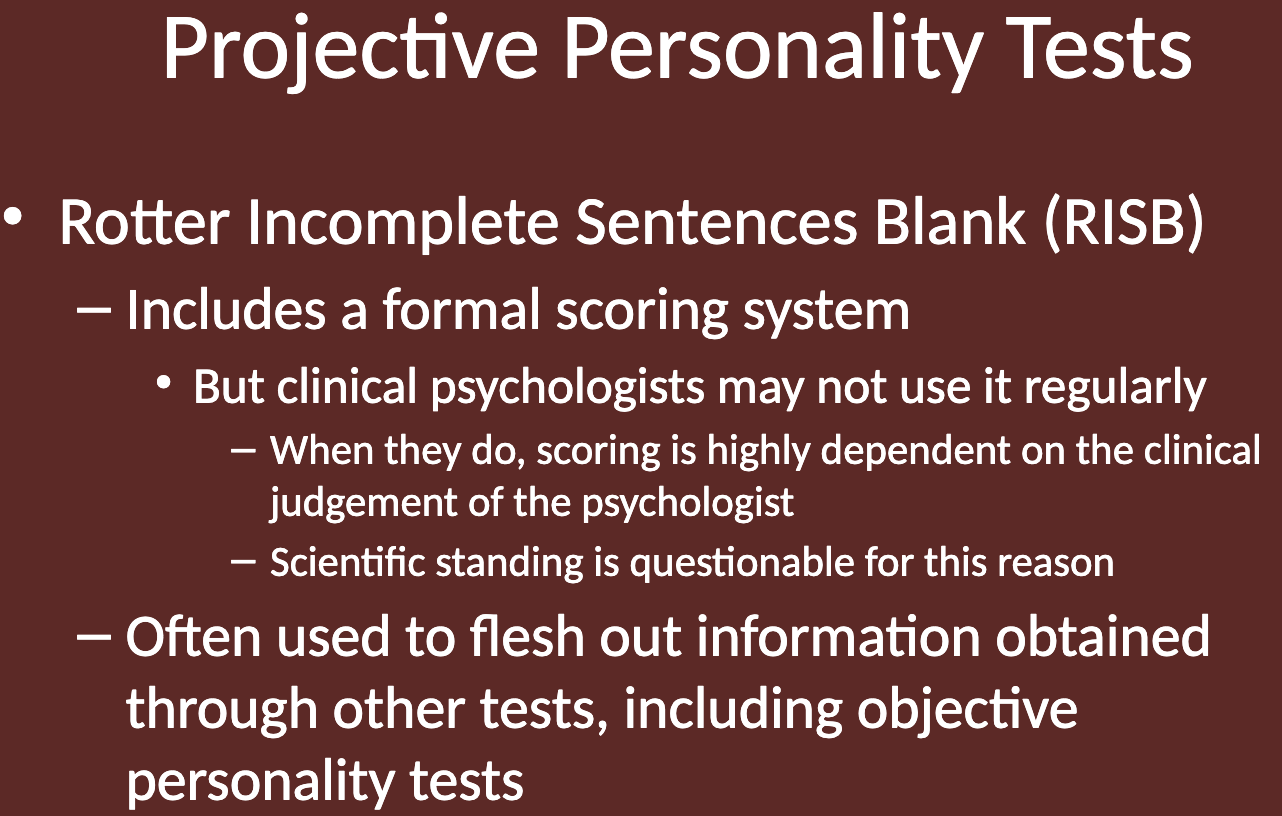Lecture 11: Personality Assessment and Behavioral Assessment
1/65
Earn XP
Description and Tags
By Jordana Burstein for Clinical Psychology
Name | Mastery | Learn | Test | Matching | Spaced |
|---|
No study sessions yet.
66 Terms
Three Overarching Themes of personality and behavioral assessment (themes)
Multimethod assessment
Evidence-based assessment
Culturally competent assessment

Why should clinical psychologists avoid relying exclusively on a single assessment method? (themes: multi)
No measure of personality or behavior is perfect.
Because of this, it is important for clinical psychologists not to rely exclusively on any single assessment method. Relying on just one method may lead to incomplete or biased conclusions. Using multiple assessment methods helps provide a more comprehensive and accurate understanding of the client's personality and behavior.
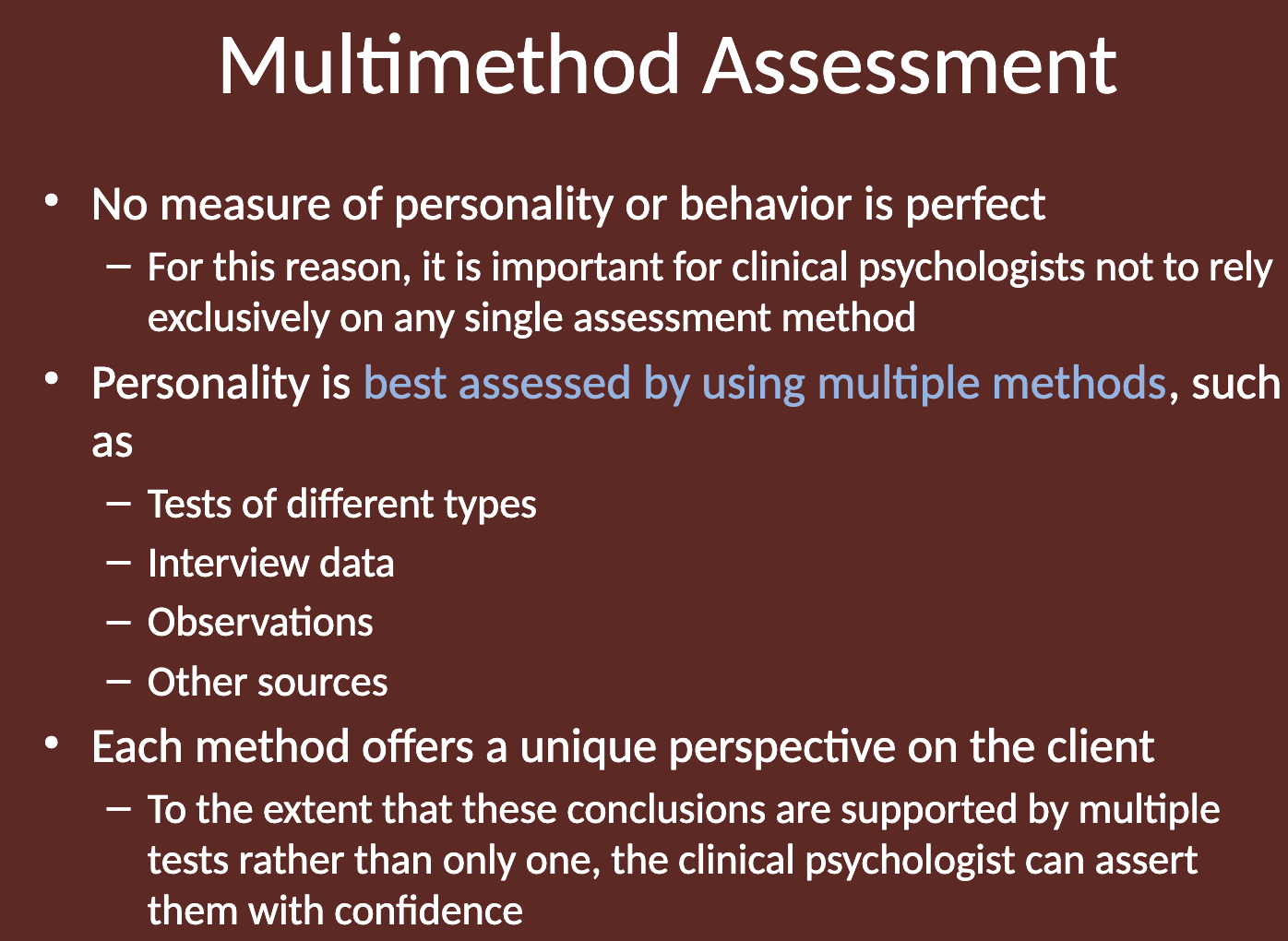
Theme One: Multimethod assessment (themes: multi)
Multimethod Assessment acknowledges that no measure of personality or behavior is perfect, so clinical psychologists should not rely solely on one assessment method.
Personality is best assessed through multiple methods, such as tests of different types, interview data, observations, and other sources.
Each method offers a unique perspective on the client, and when these conclusions are supported by multiple methods, the psychologist can assert them with greater confidence.
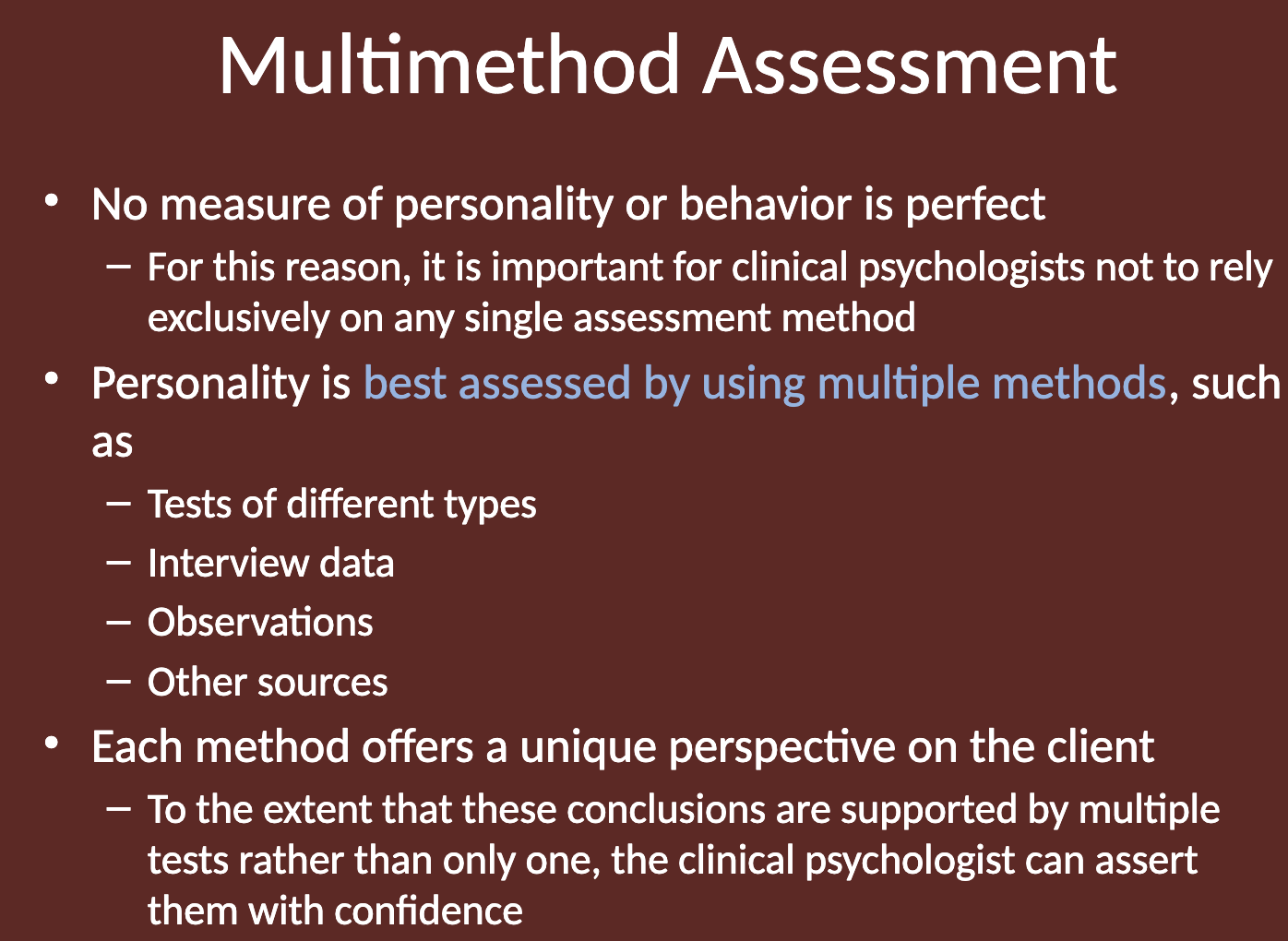
Personality is best assessed by using ___ assessments. (themes: multi)
multiple methods; such as
Tests of different types
Interview data
Observations
Other sources

Theme Two: Evidence-based assessment (themes: evidence)
Clinical psychologists practicing evidence-based assessment use methods with strong psychometrics, such as high reliability, validity, and clinical utility.
They target their assessment strategies toward a particular diagnosis or problem, understanding that different disorders require different tools.
For example, the assessment tools used for attention-deficit/hyperactivity disorder may differ from those used for panic disorder or schizophrenia.
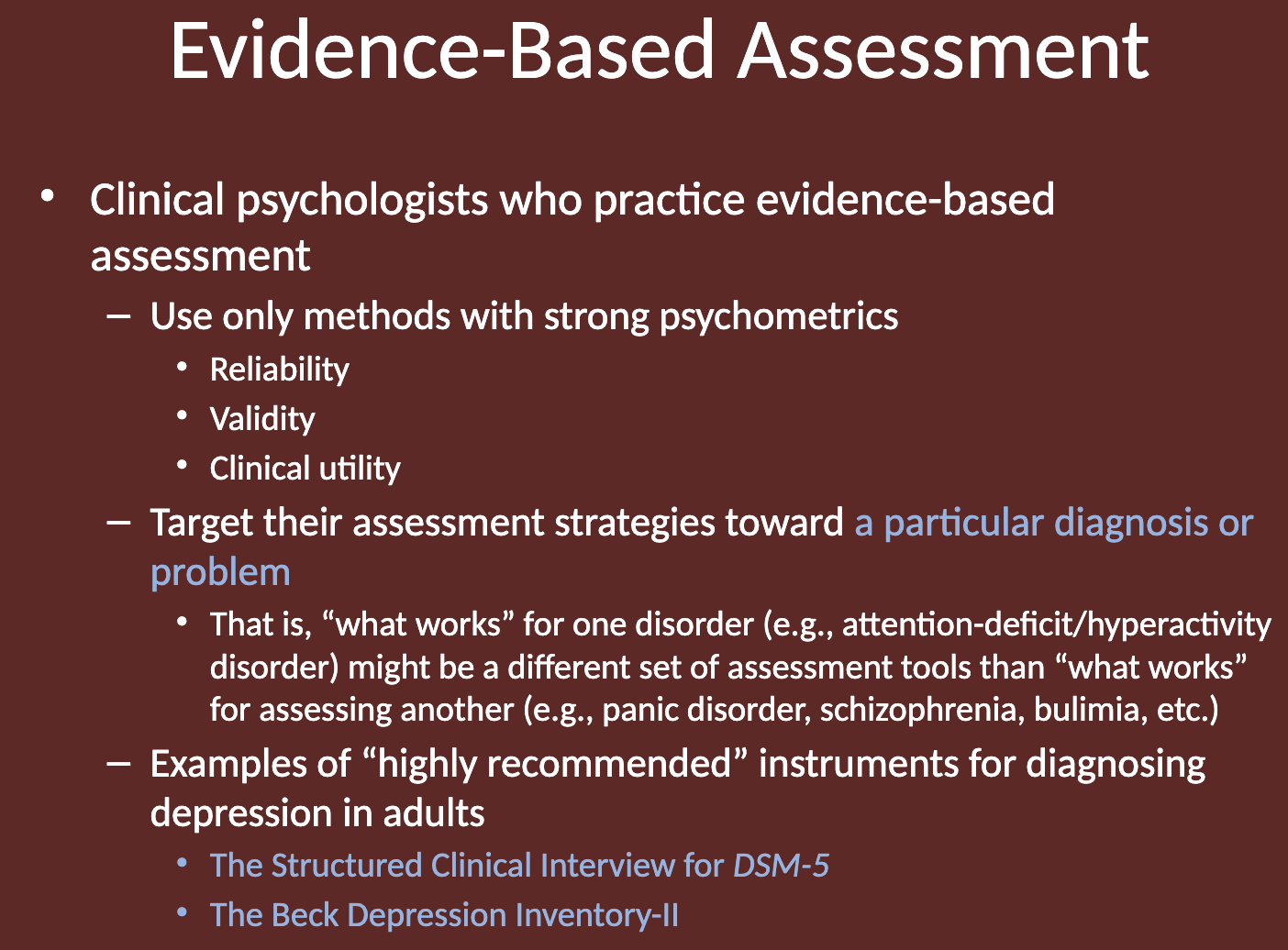
What are some highly recommended instruments for diagnosing depression in adults? (themes: evidence)
Two highly recommended instruments for diagnosing depression in adults are the Structured Clinical Interview for DSM-5 and the Beck Depression Inventory-II.
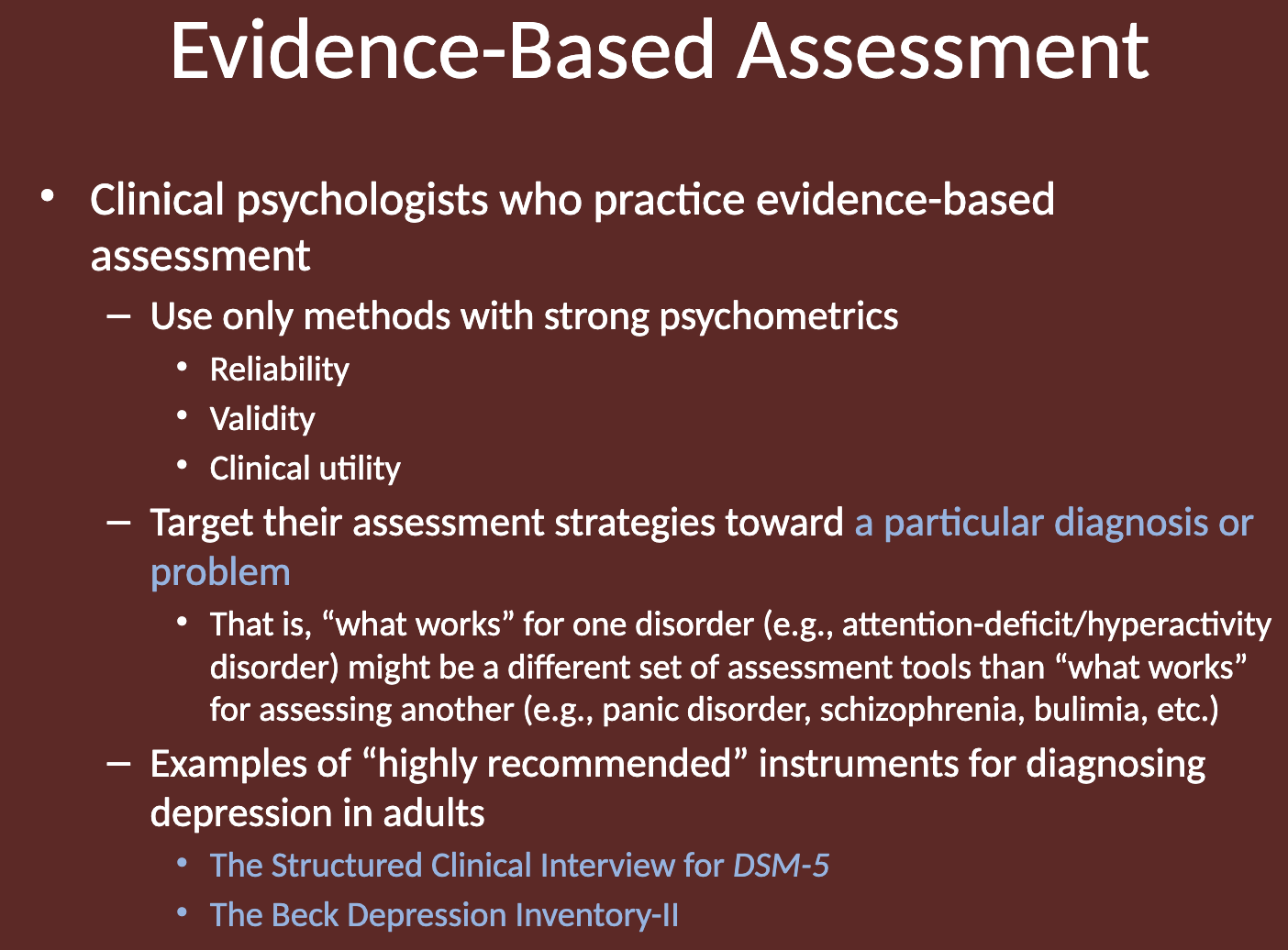
What is one of the great challenges in developing evidence-based assessment? (themes: evidence)
One of the great challenges in developing evidence-based assessment is determining "what works."
This involves identifying which assessment methods are most effective and reliable for diagnosing specific psychological disorders.

How can strengths or weaknesses be assessed quantitatively in evidence-based assessment to determine “what works”? (themes: evidence)
Strengths or weaknesses can be assessed quantitatively by measuring the extent to which a method yields consistent results over time, such as through test-retest reliability. This helps determine whether an assessment method is effective or not.

What is test-retest reliability in evidence-based assessment? (themes: evidence)
Test-retest reliability measures the extent to which a method yields similar results at different time points, ensuring consistency over time. It is a key indicator of the stability of an assessment method.

What is the correlation coefficient range for test-retest reliability? (themes: evidence)
The correlation coefficient for test-retest reliability ranges from -1 to +1, with higher values indicating stronger reliability.
A coefficient closer to +1 indicates that the assessment method yields consistent results.
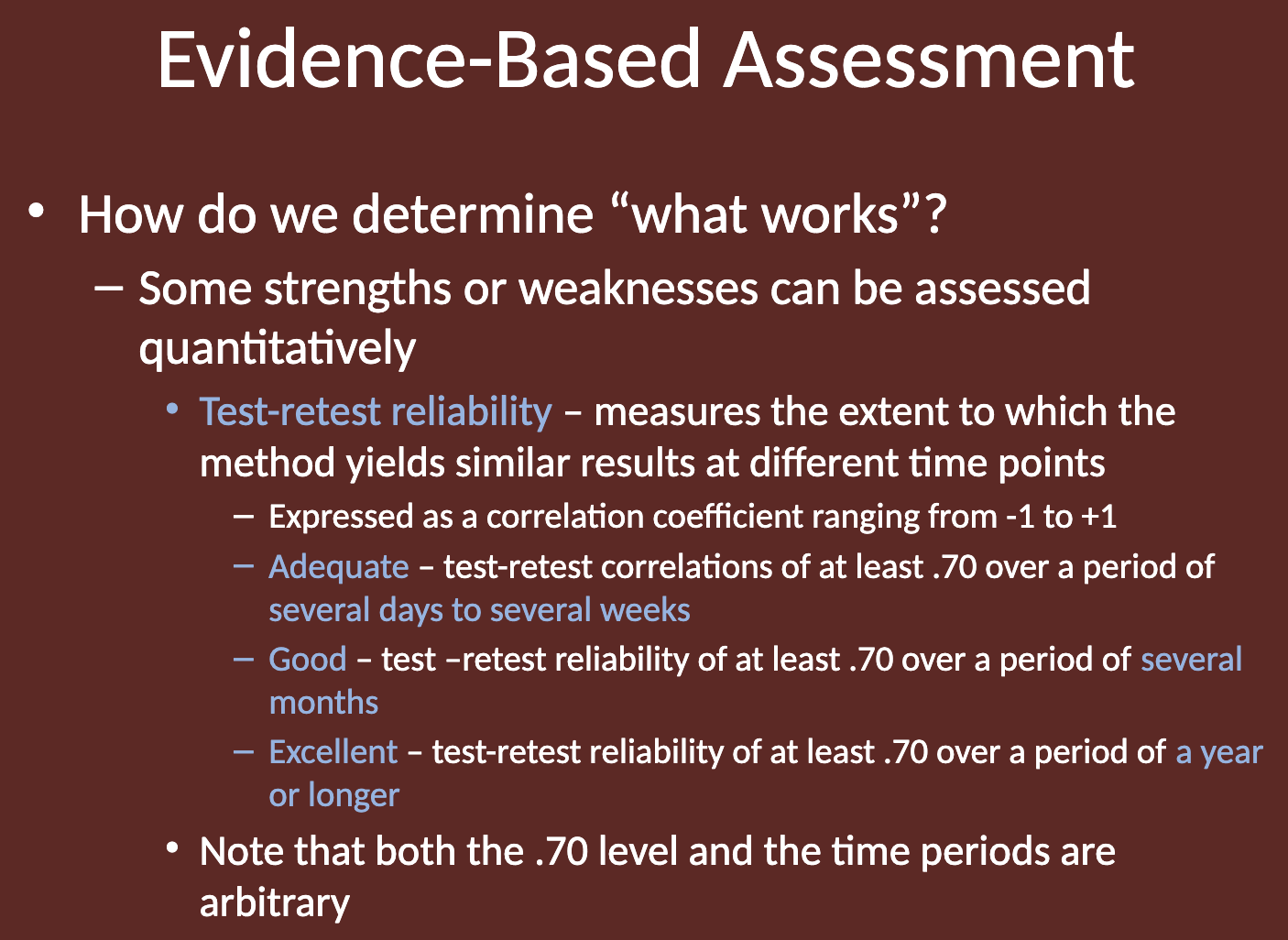
What is considered an adequate test-retest reliability? (themes: evidence)
Adequate test-retest reliability is considered to be a correlation of at least .70 over a period of several days to several weeks.
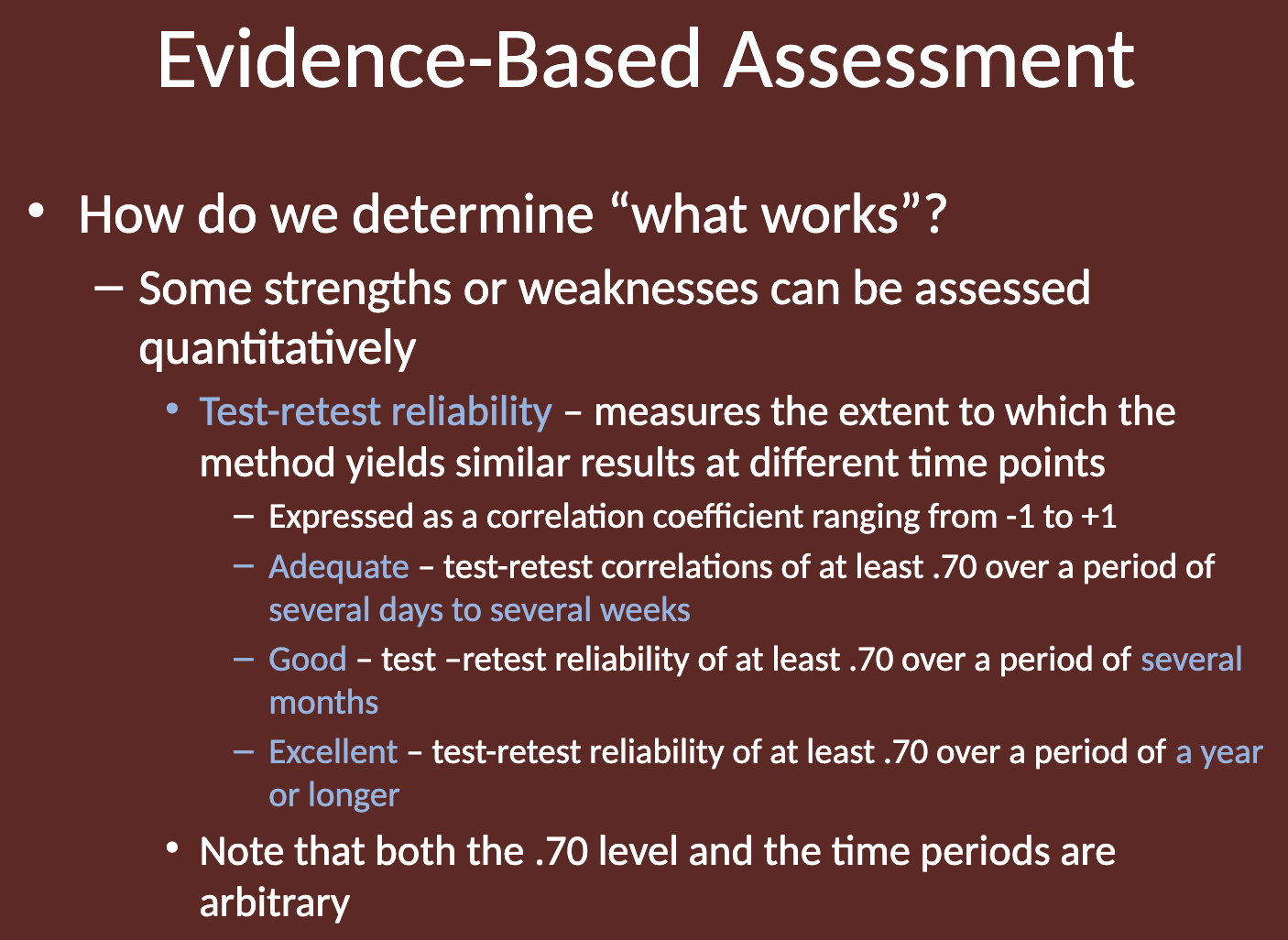
What is considered good test-retest reliability? (themes: evidence)
Good test-retest reliability is considered to be a correlation of at least .70 over a period of several months.
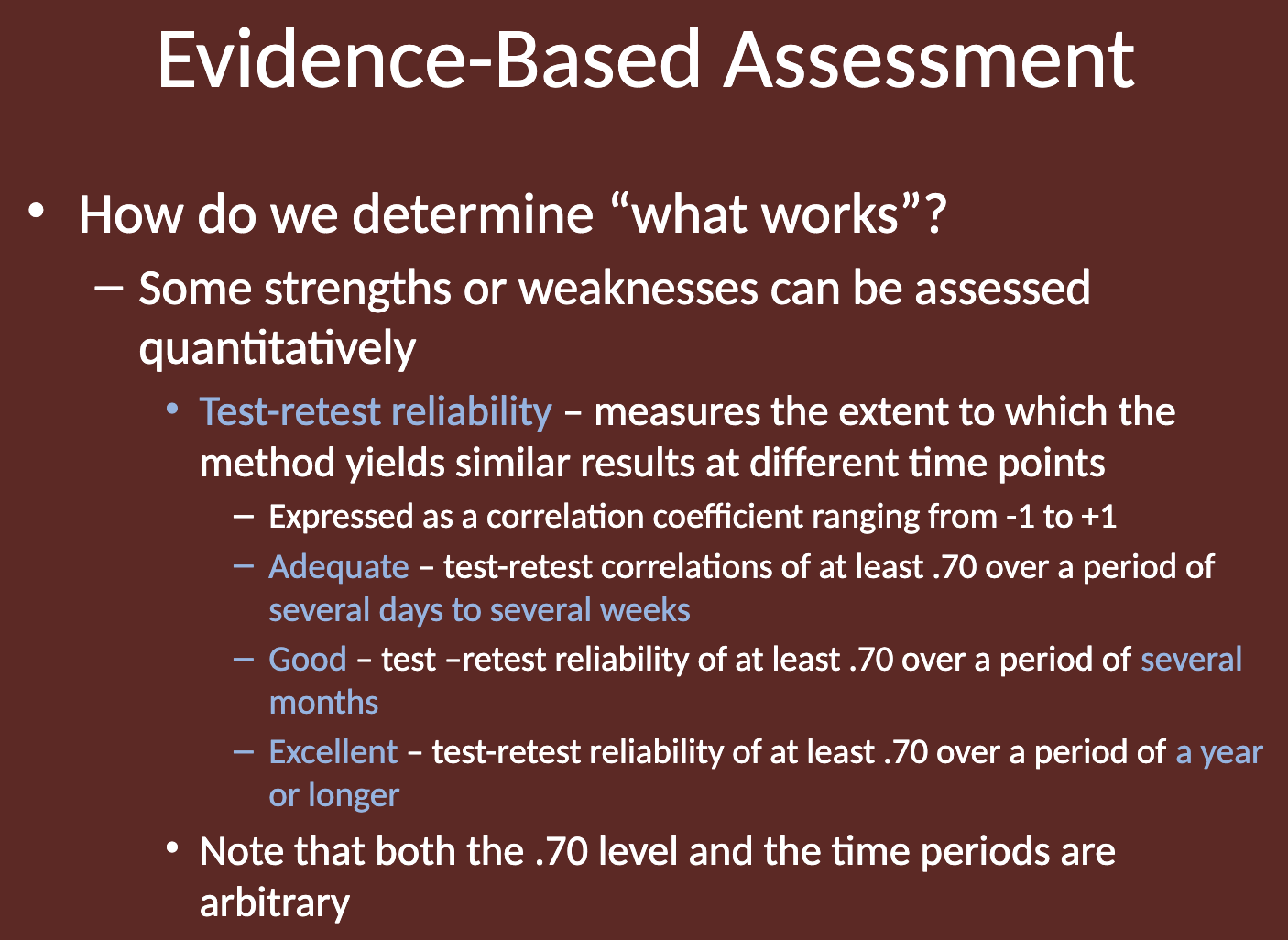
What is considered excellent test-retest reliability? (themes: evidence)
Excellent test-retest reliability is considered to be a correlation of at least .70 over a period of a year or longer.
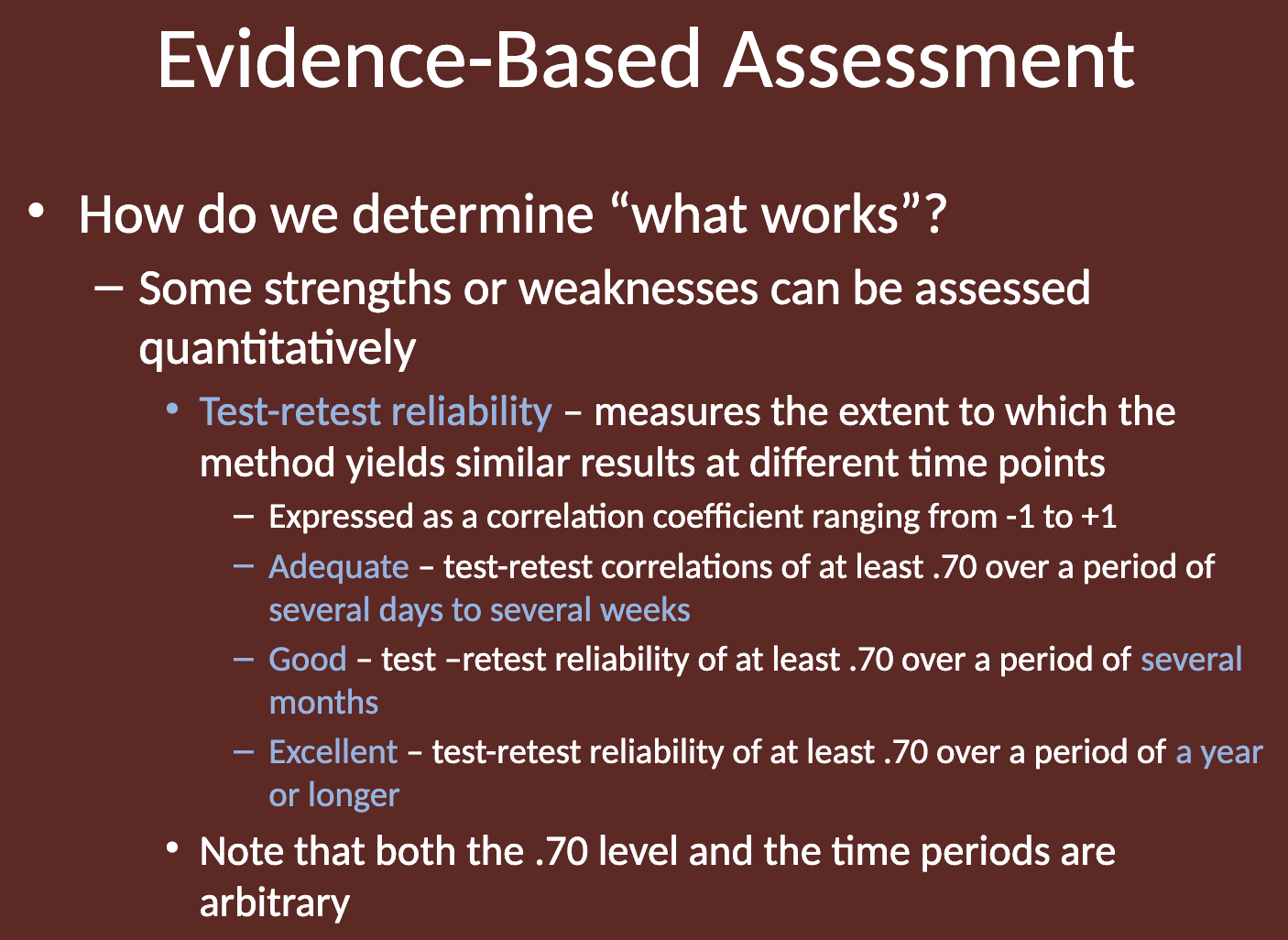
Why are the time periods used in test-retest reliability considered arbitrary? (themes: evidence)
The time periods used for assessing test-retest reliability (e.g., days, months, or years) are arbitrary because there is no universally accepted standard.
They are chosen based on the specific context of the assessment and what is deemed appropriate for the disorder or behavior being measured.
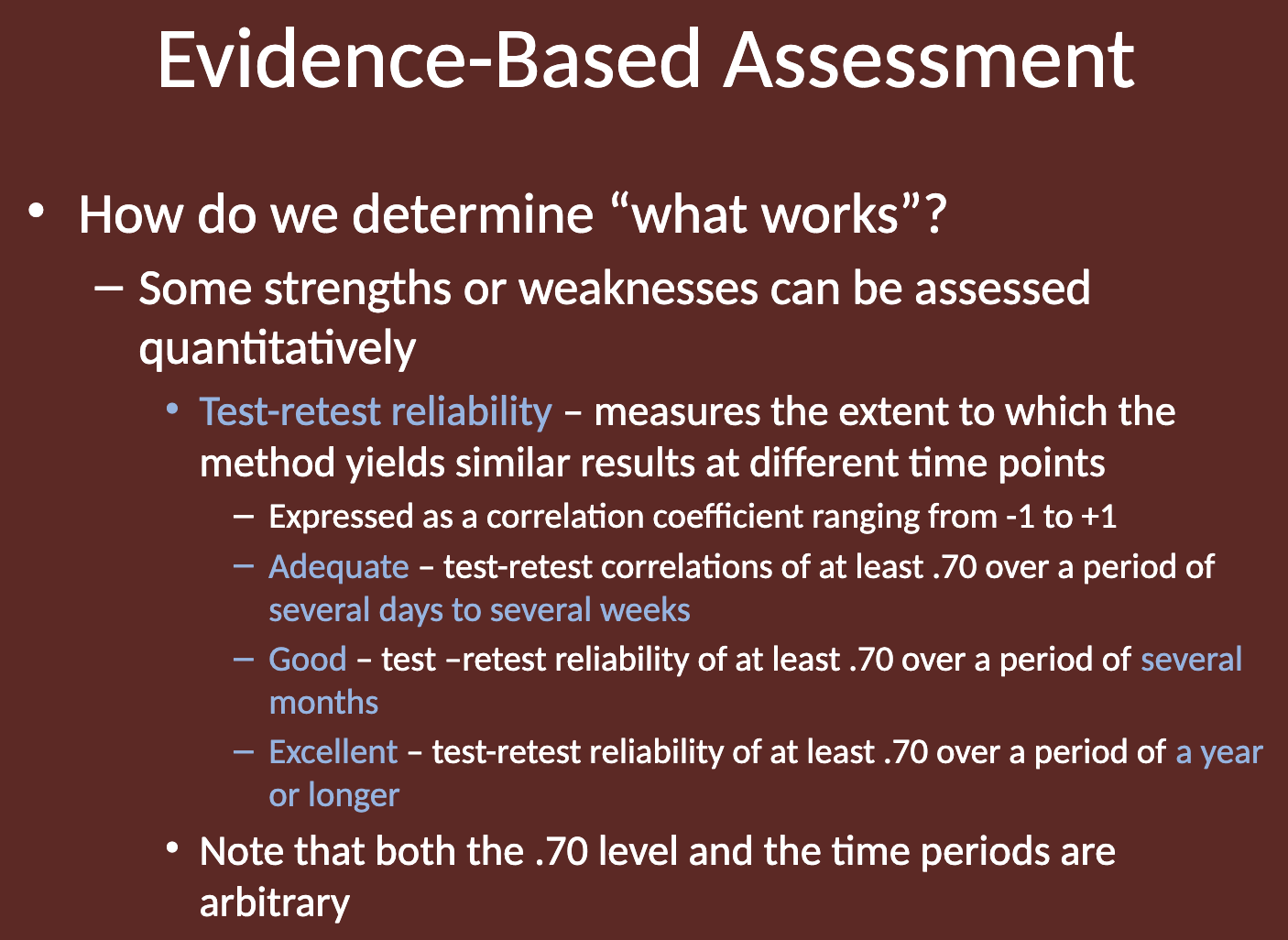
What do Sommers-Flanagan and Sommers-Flanagan (2009) argue about using guidebooks or manuals in clinical assessment? (themes: evidence)
That not every decision in clinical assessment should be predetermined by guidebooks or manuals. They point out that these manuals cannot address the nuances of human interaction, such as emotions like anger or tears, or guide clinicians on when to self-disclose, when to listen, or how to establish rapport with a culturally unique individual.
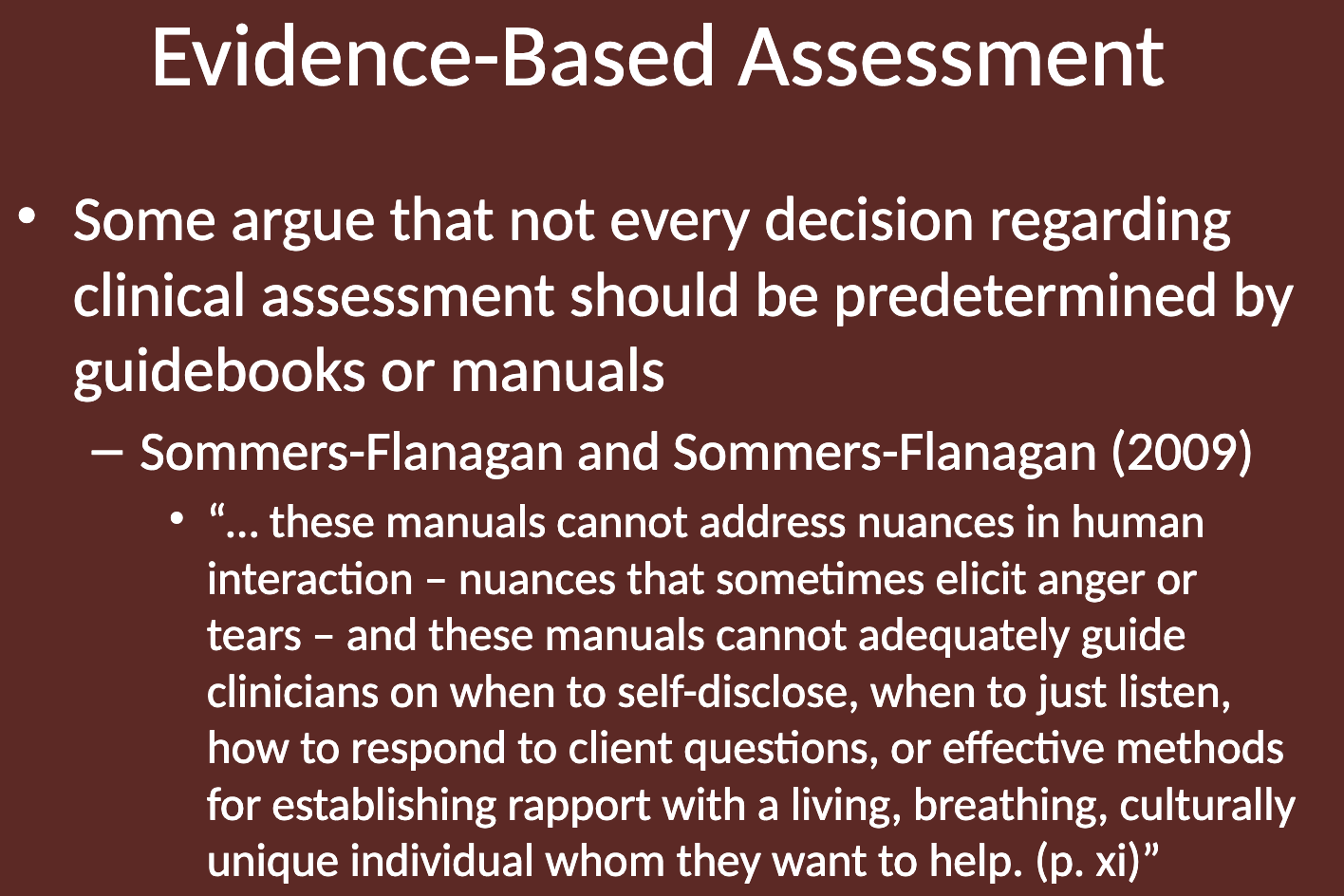
Theme Three: Culturally competent assessment (themes: culture)
Culturally competent assessment involves recognizing and understanding the cultural differences in perceptions of "normal" and "abnormal."
It requires sensitivity to the client’s culture to ensure that personality assessments are appropriate and accurate. Without cultural awareness, assessments can lead to harm, often referred to as cultural malpractice.
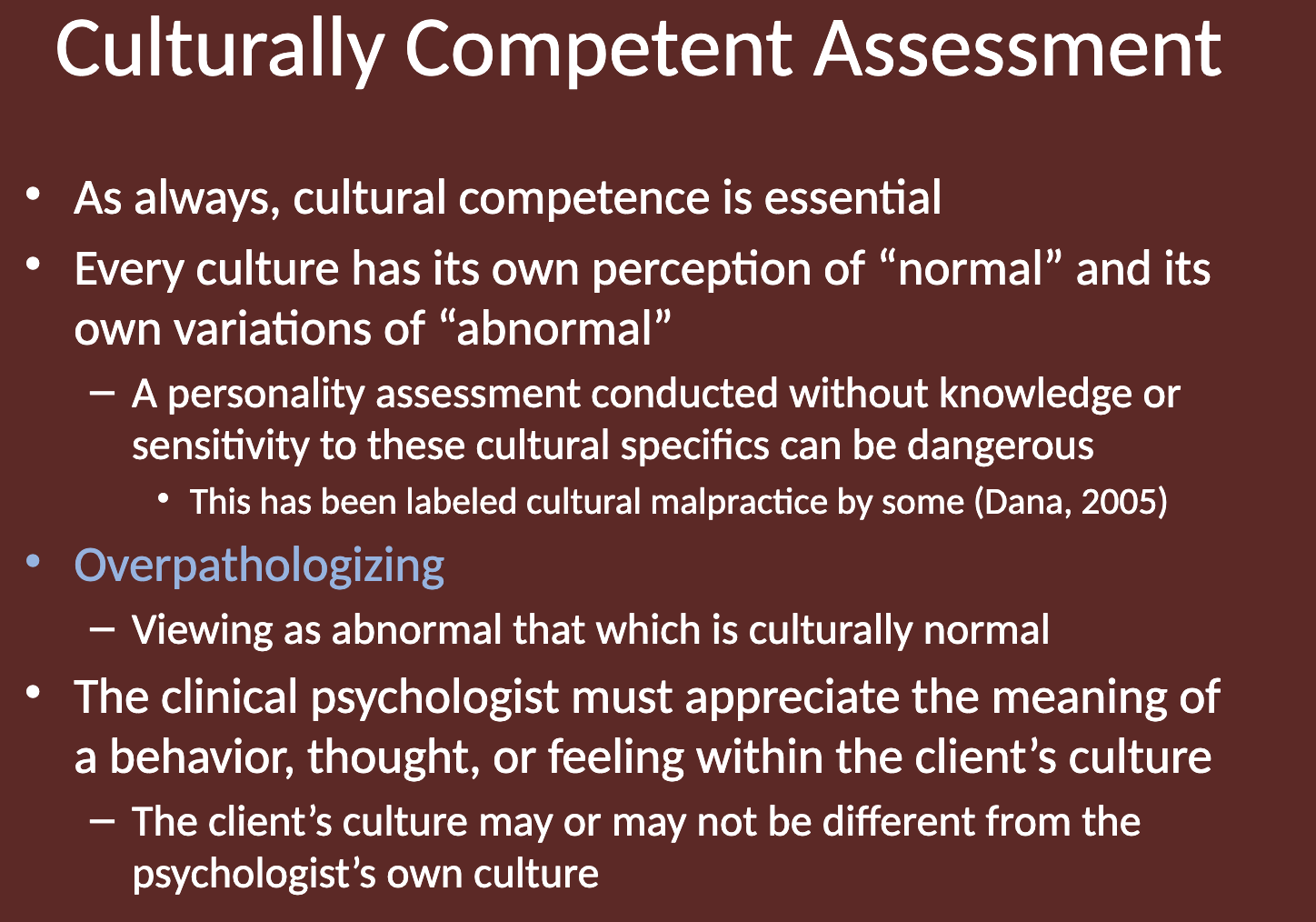
What does overpathologizing mean in clinical psychology? (themes: culture)
Overpathologizing occurs when behaviors or traits that are culturally normal are mistakenly viewed as abnormal.
This happens when a clinical psychologist fails to consider the client's cultural context, leading to misinterpretation of behaviors, thoughts, or feelings.
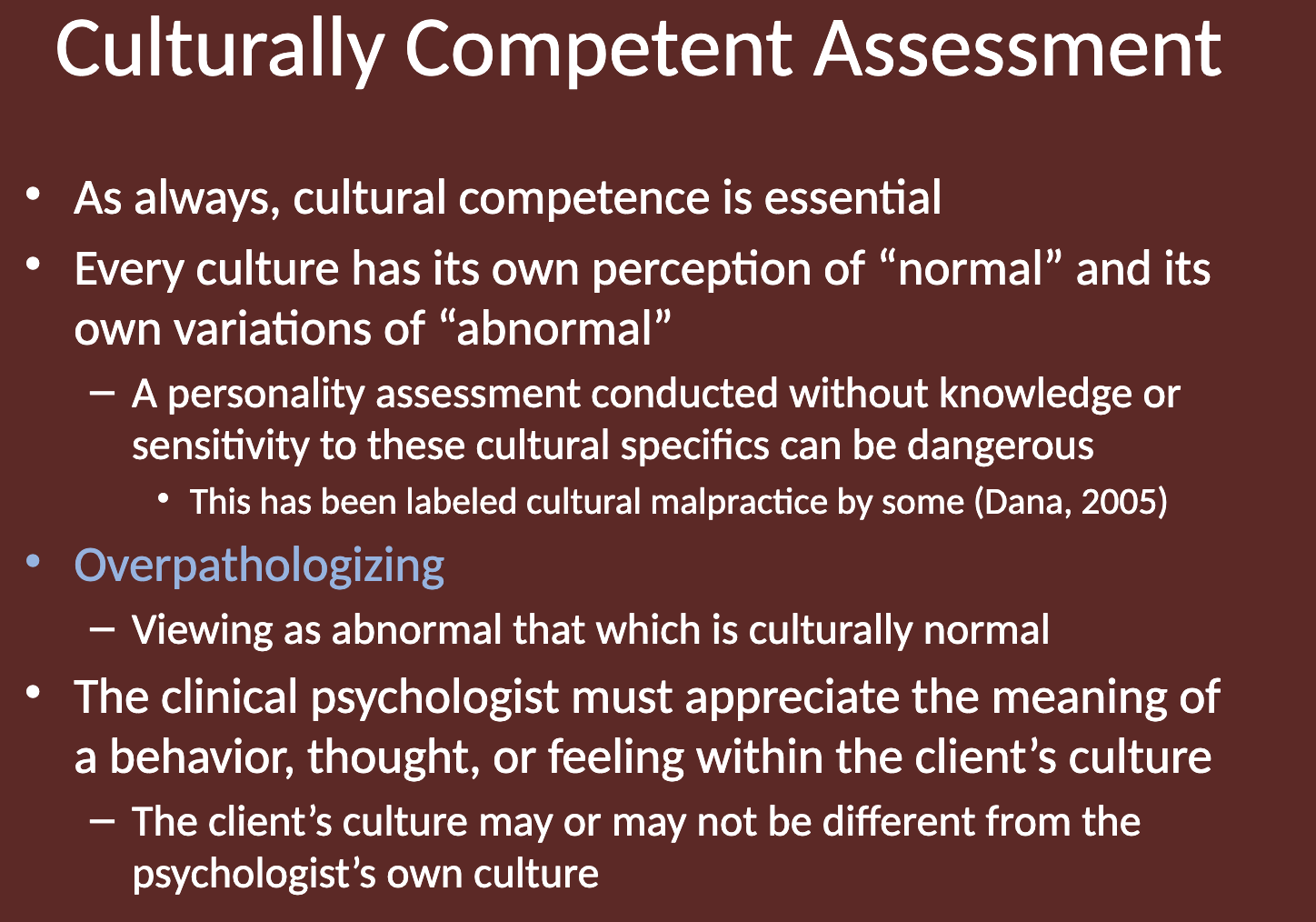
Two types of personality tests (objective v projective)
The two types of personality tests are Objective Personality Tests and Projective Personality Tests.

What is an objective personality test? (objective)
An objective personality test includes unambiguous test items, offers a limited range of responses (such as true/false or multiple-choice), and is objectively scored. These tests are typically paper-and-pencil questionnaires with direct, brief statements or questions.
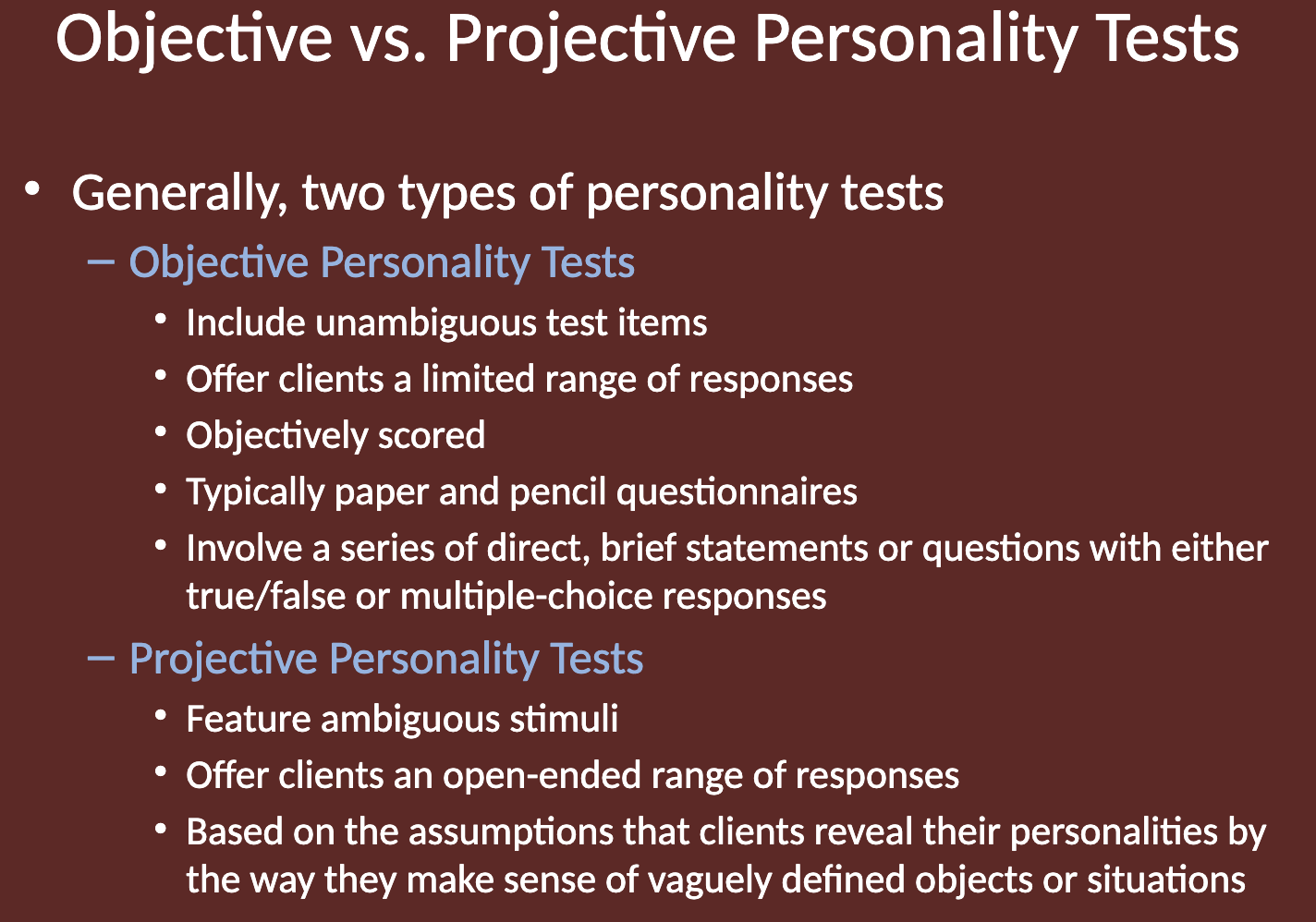
What is a projective personality test? (projective)
A projective personality test features ambiguous stimuli and offers an open-ended range of responses. It is based on the assumption that clients reveal their personalities by how they make sense of vaguely defined objects or situations.

What is the MMPI-2? (objective: MMPI)
The MMPI-2 (Minnesota Multiphasic Personality Inventory-2) is the most popular and psychometrically sound objective personality test used by clinical psychologists. It is used in many countries and cultures around the world and has been translated into dozens of languages.
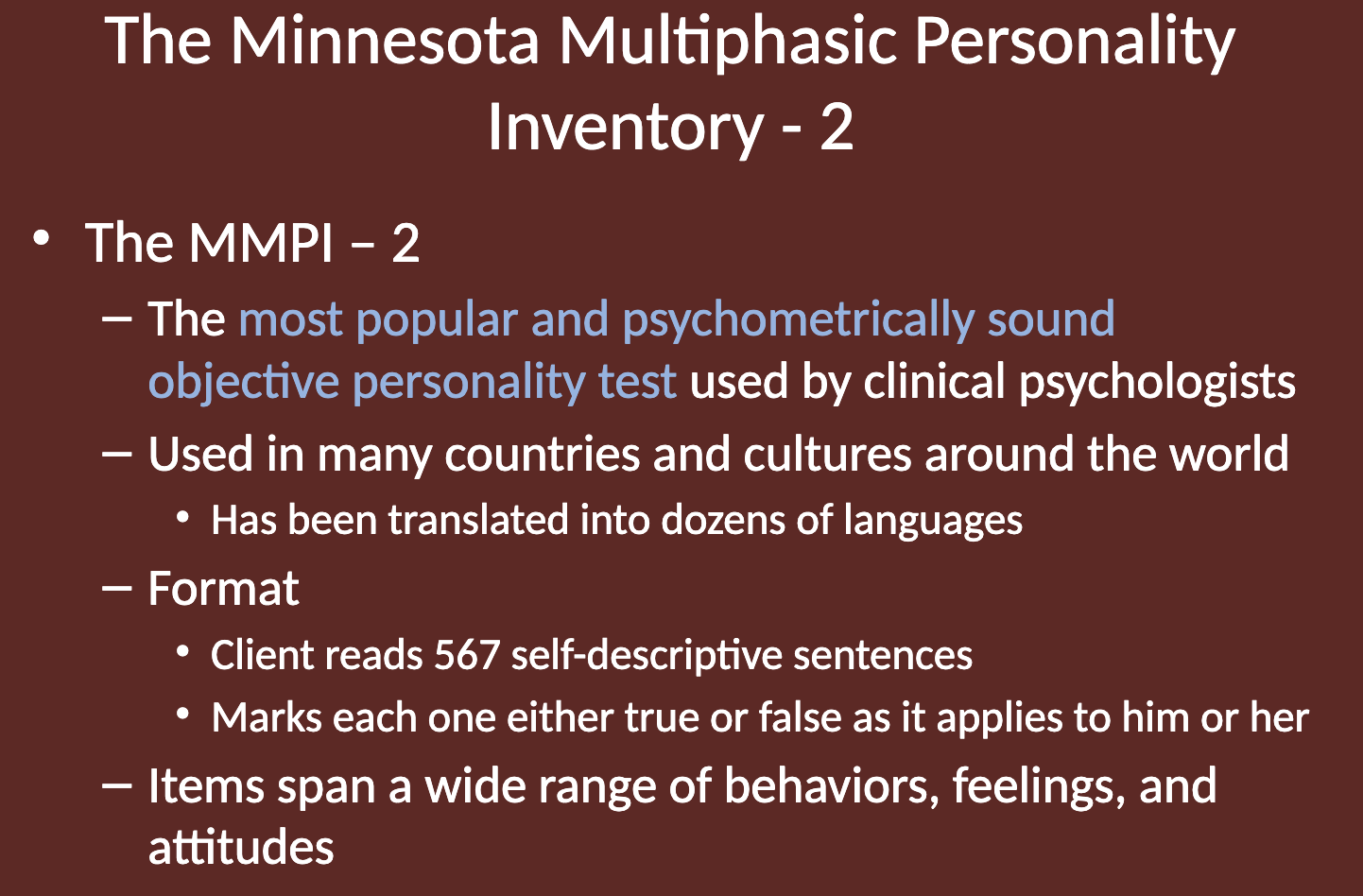
What is the format of the MMPI-2? (objective: MMPI)
The MMPI-2 consists of 567 self-descriptive sentences. The client reads each sentence and marks it as either true or false, depending on whether it applies to them. The items cover a wide range of behaviors, feelings, and attitudes.
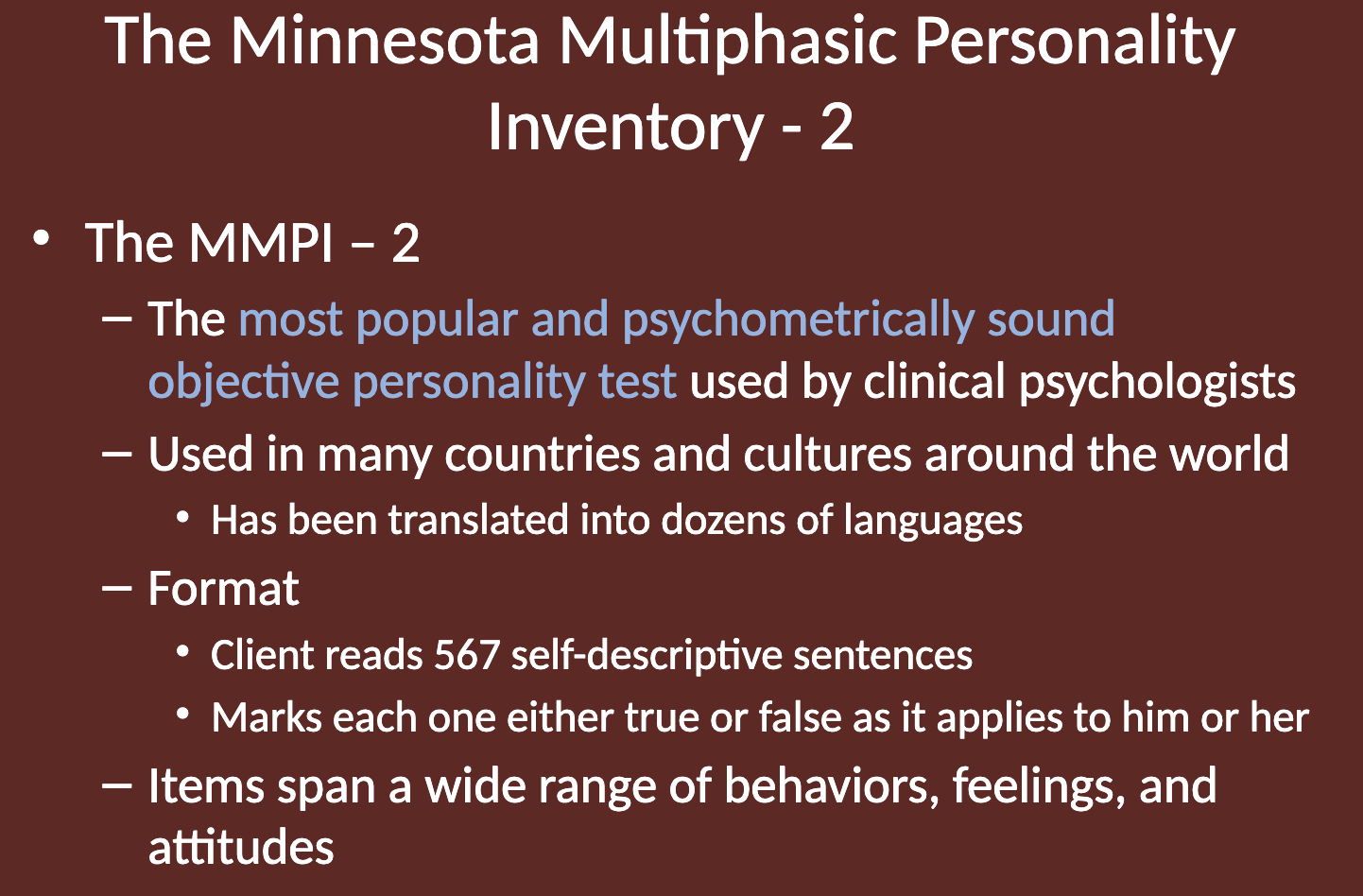
What are some example items from the Minnesota Multiphasic Personality Inventory-2 (MMPI-2)? (objective: MMPI)
Some example items from the MMPI-2 include:
"I feel like I am low on energy much of the time."
"I often find myself in conflicts with people in authority."
"During times of stress, I usually experience an upset stomach."
"Most of the people I know have plans to hurt me in some way."
"I have visions of things that aren’t real and that other people can’t see."
"I enjoy going to social events with dozens of people."
"I often can’t stop worrying about things even when there is no reason for the worry."
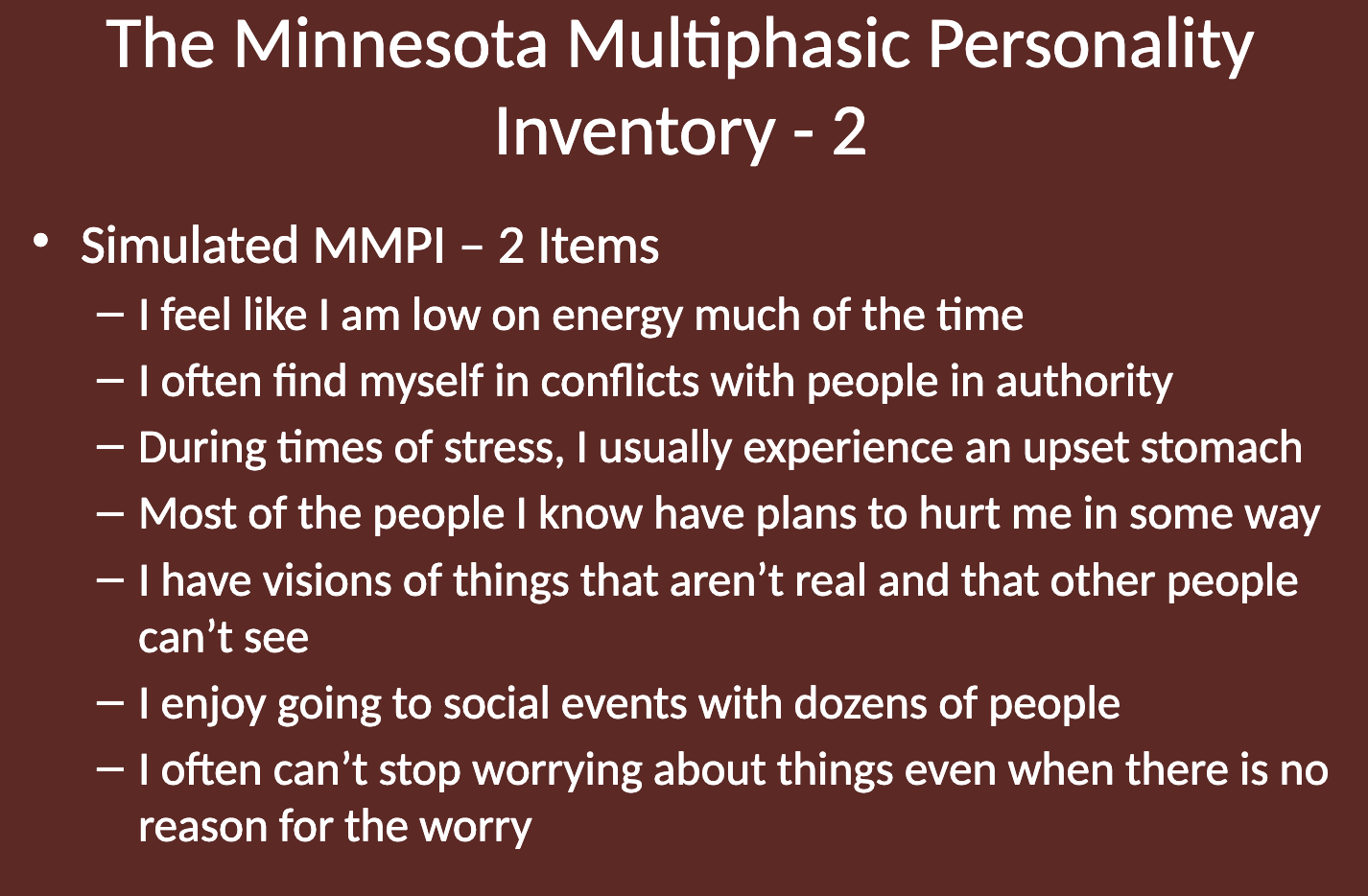
What is the history of the original MMPI? (objective: MMPI)
The original MMPI was created by Starke Hathaway and J.C. McKinley in 1943, after they began work on it in the 1930s. They sought to develop an objective way to measure psychopathology.
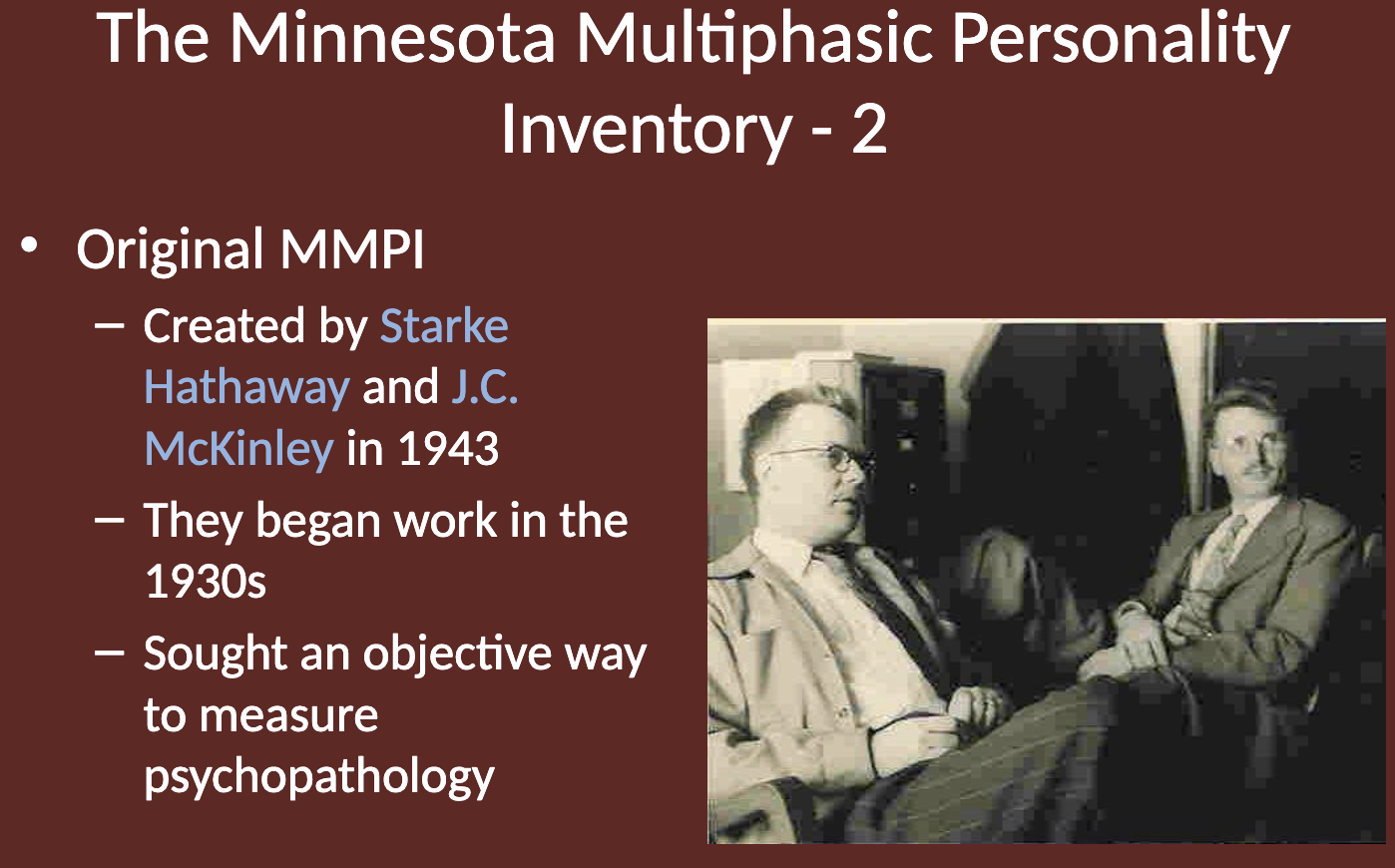
How did Hathaway and McKinley create the MMPI? (objective: MMPI)
Hathaway and McKinley took on the challenge of creating the MMPI by empirically selecting items that would elicit different responses from "normal" and "abnormal" individuals, rather than just theorizing which items would differentiate them.
This approach allowed them to base the test on actual empirical differences observed in these groups.

What method of test construction did Hathaway and McKinley use for the MMPI-2? (objective: MMPI)
Empirical Criterion Keying
Involves identifying distinct groups of people, having them respond to the same test items, and selecting items that show different response patterns between groups.
If an item elicits different responses from one group than another, it is considered valuable and included in the test.
If an item elicits similar responses from both groups, it is discarded, as it doesn't help differentiate between groups.
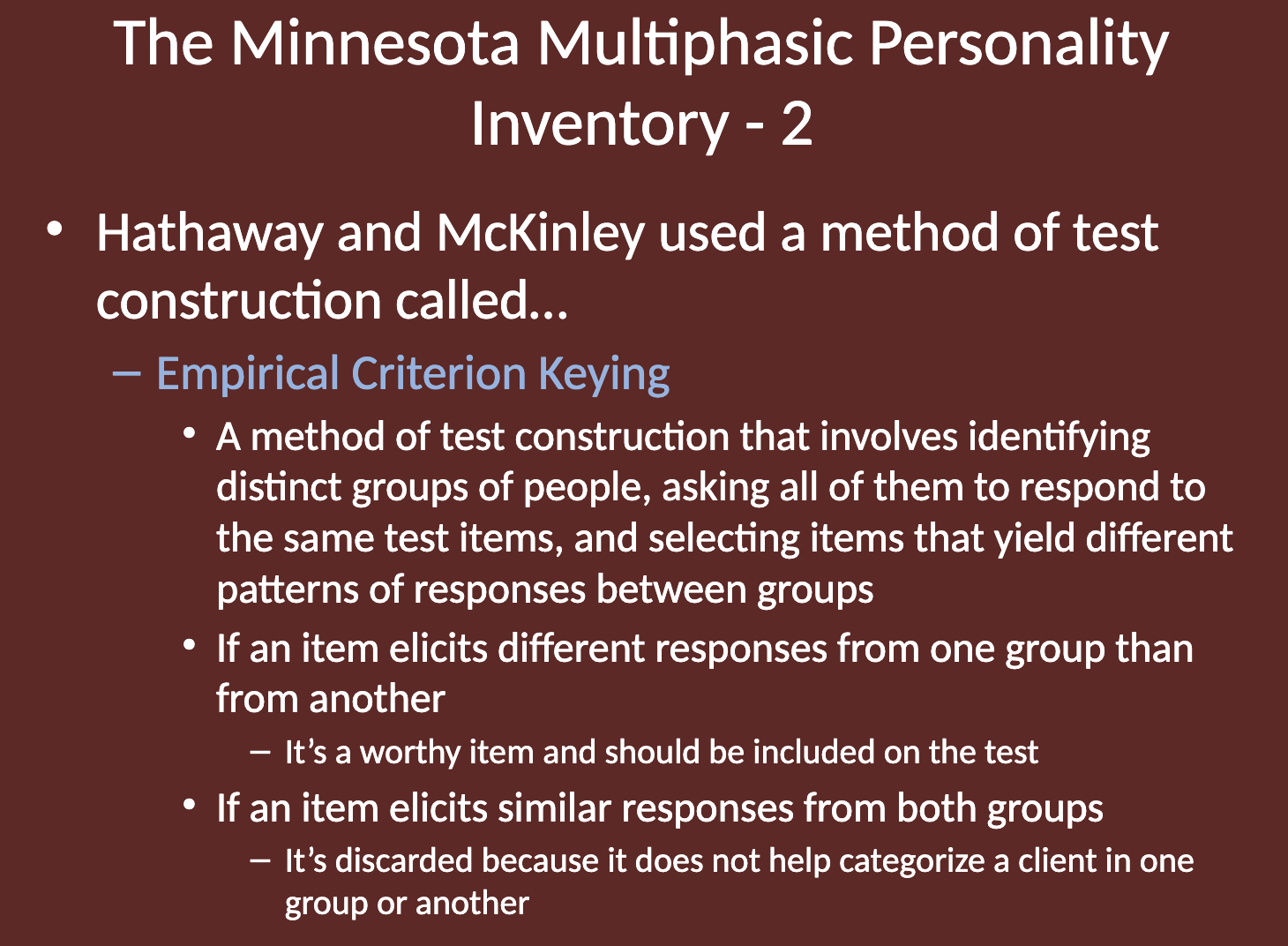
What is a key characteristic of the Empirical Criterion Keying method used in the MMPI-2? (objective: MMPI)
Theoretical expectations are not enough; evidence is required.
It doesn't matter whether an item "should" differentiate two groups in theory, only if it actually does in practice.
Example: The item “I have visions of things that aren’t real and that other people can’t see” might theoretically be expected to be endorsed more by those with schizophrenia. However, empirical criterion keying requires evidence that people with schizophrenia actually endorse it more often than those without.
This can lead to low face validity because the items may not always align with theoretical expectations.
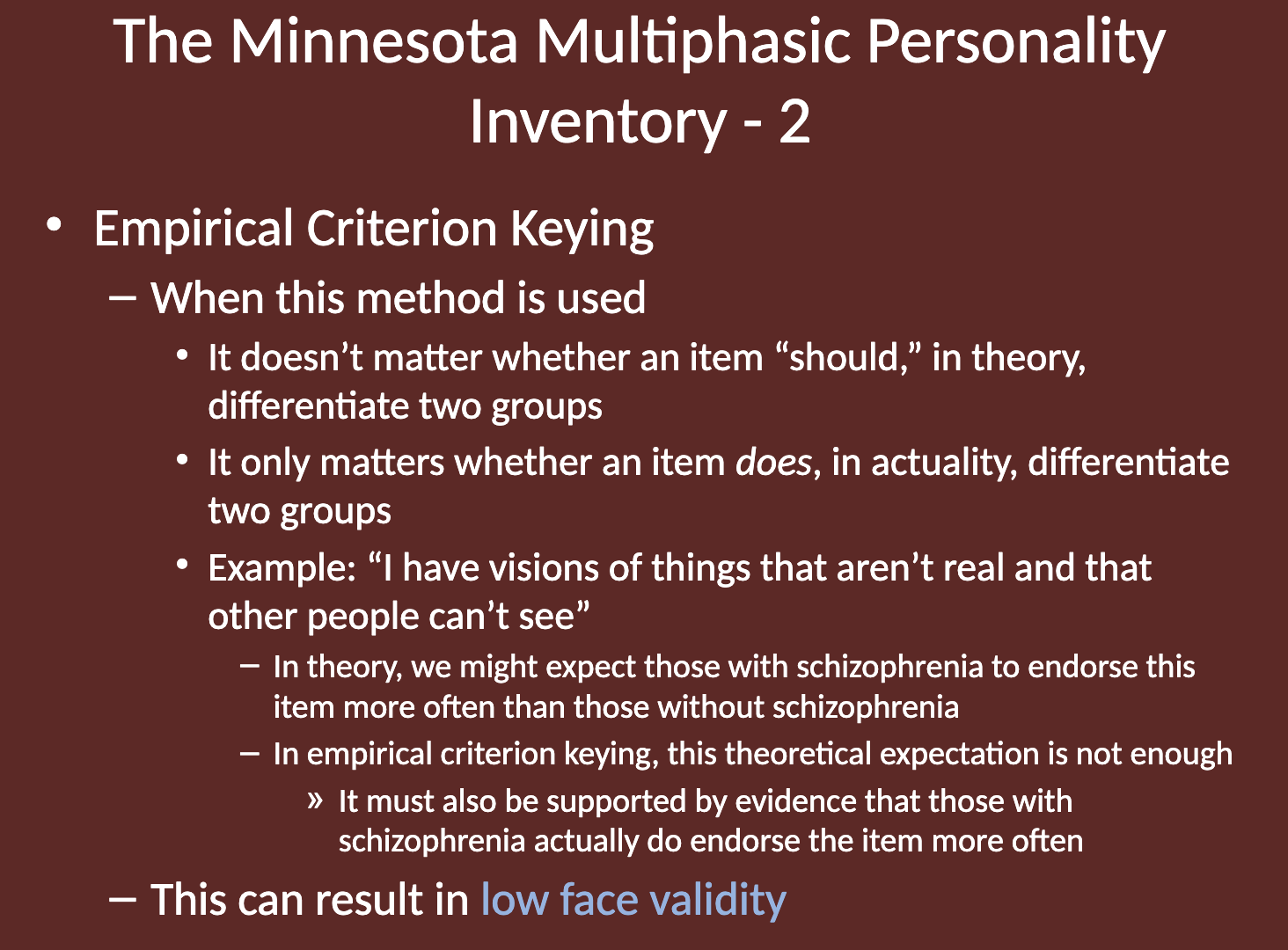
What is low face validity? (objective: MMPI)
Low face validity refers to the extent to which a test appears, at face value, to measure what it claims to measure.
In the context of the MMPI, it indicates that the items may not intuitively seem relevant or appropriate for assessing the psychological constructs they are designed to evaluate.
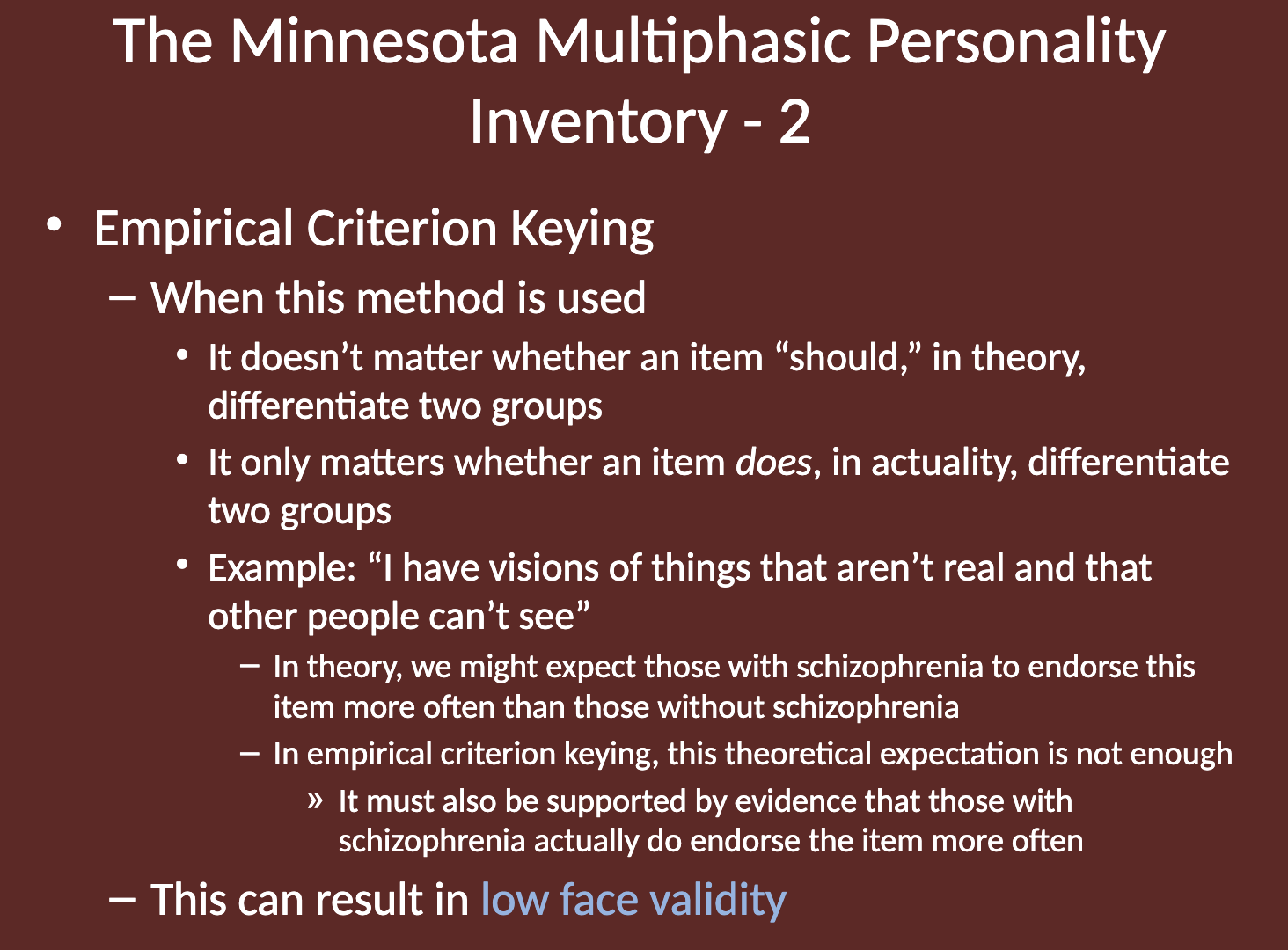
How did Hathaway and McKinley develop the MMPI-2, and how are the items organized? (objective: MMPI)
Started with 1,000 items; 550 remained after applying the empirical criterion keying method.
Items are presented in random order.
The items are grouped into 10 clinical scales, each related to a specific pathology.
The higher a client scores on a scale, the greater the likelihood they exhibit that form of psychopathology.
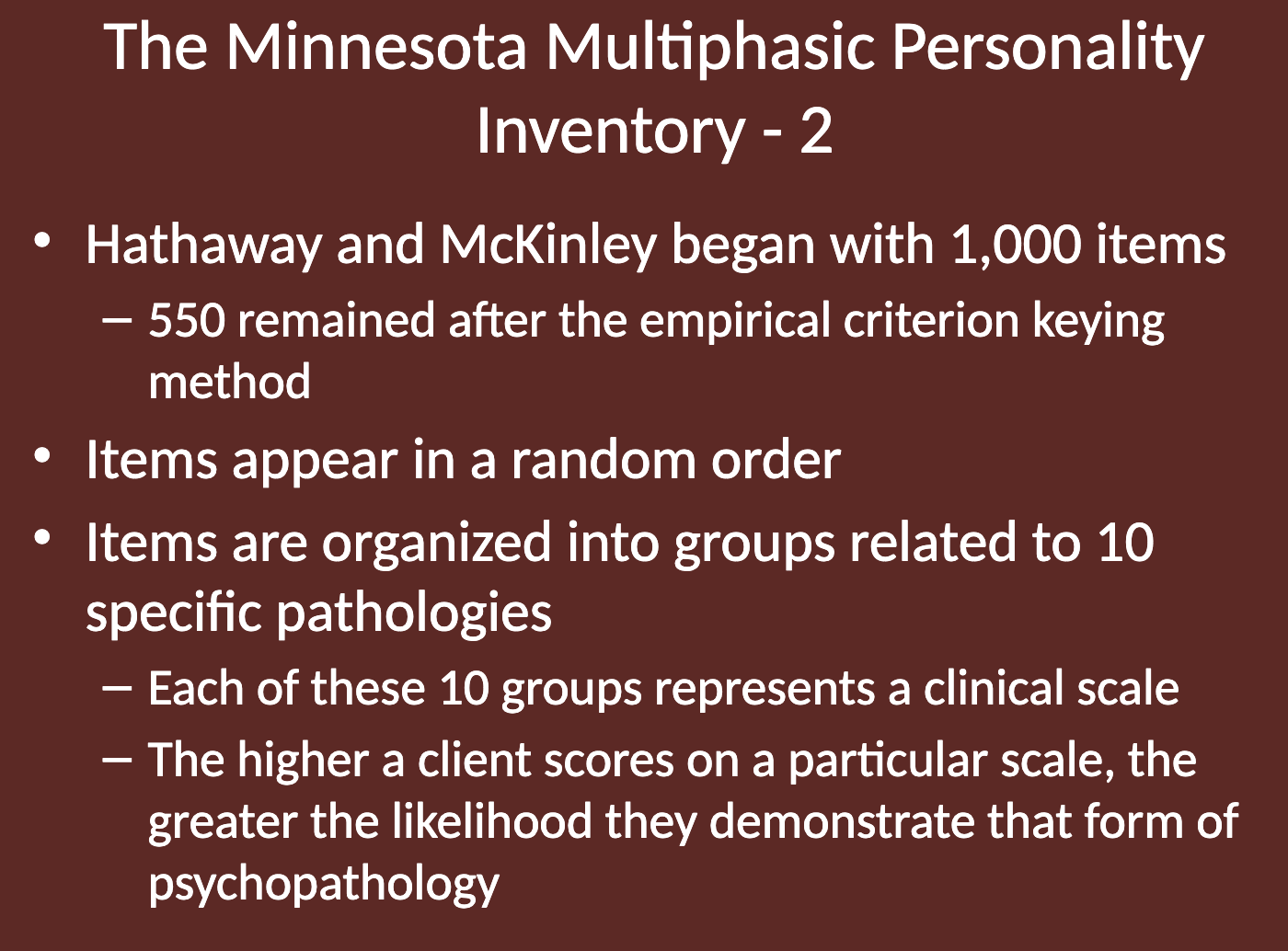
What did Hathaway and McKinley recognize about test-taking attitudes in the MMPI-2? (objective: MMPI)
They realized that self-report instruments are vulnerable to insincerity.
Some clients may "fake bad", exaggerating their symptoms.
Others may "fake good", appearing less impaired than they are.
Some clients might just respond randomly.
The MMPI and MMPI-2 include items designed to identify these test-taking attitudes.

What are validity scales in the MMPI-2, and what do they help psychologists determine? (objective: MMPI)
Scales that inform the psychologist about the client’s approach to the test.
They help psychologists determine:
Whether the test is valid.
What adjustments might be necessary when interpreting the clinical scales.
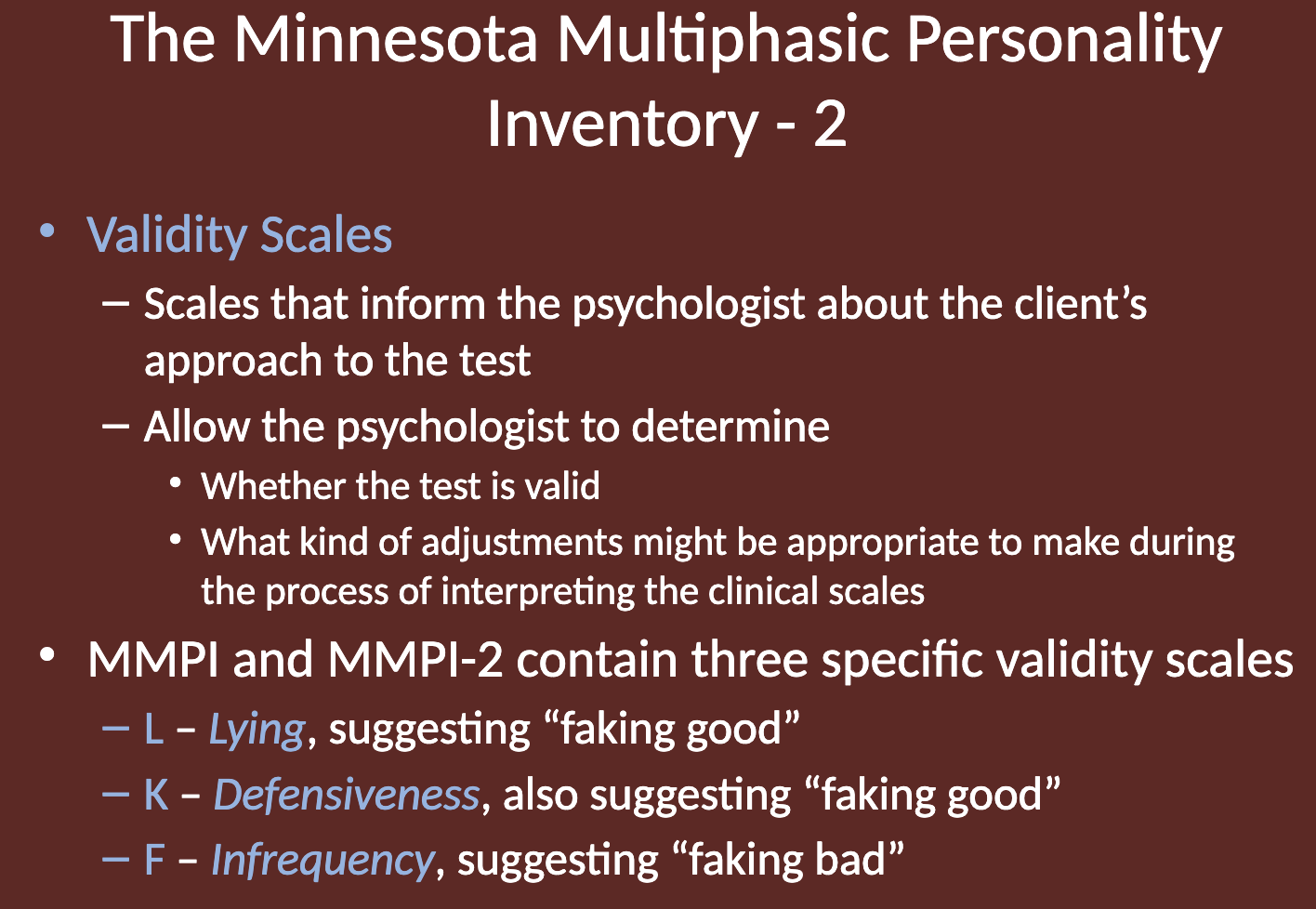
Three Validity Scales (objective: MMPI)
L: Lying
K: Defensiveness
F: Infrequency
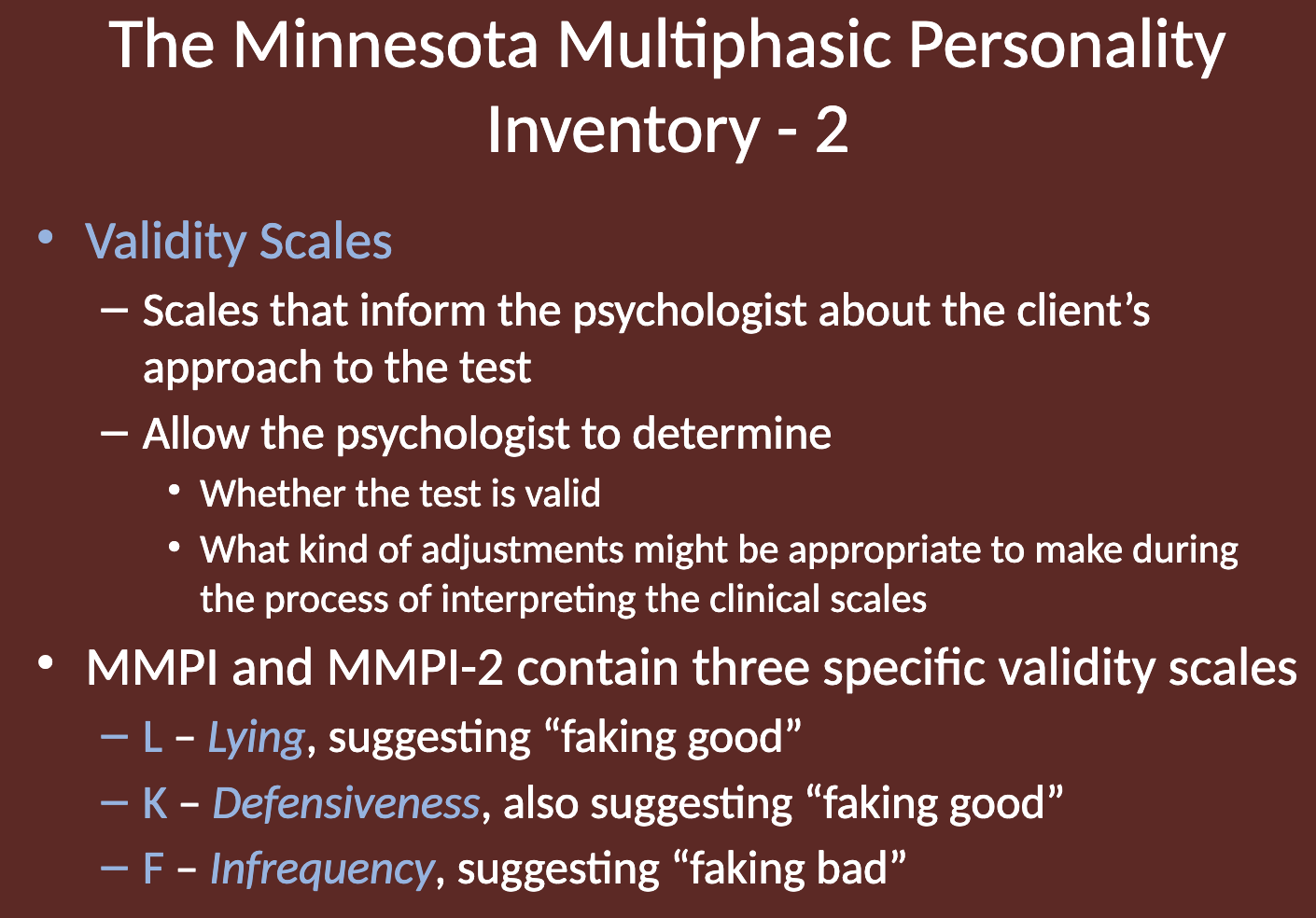
First Validity Scale: L: Lying (objective: MMPI)
Indicates "faking good" or presenting oneself in an overly favorable light.
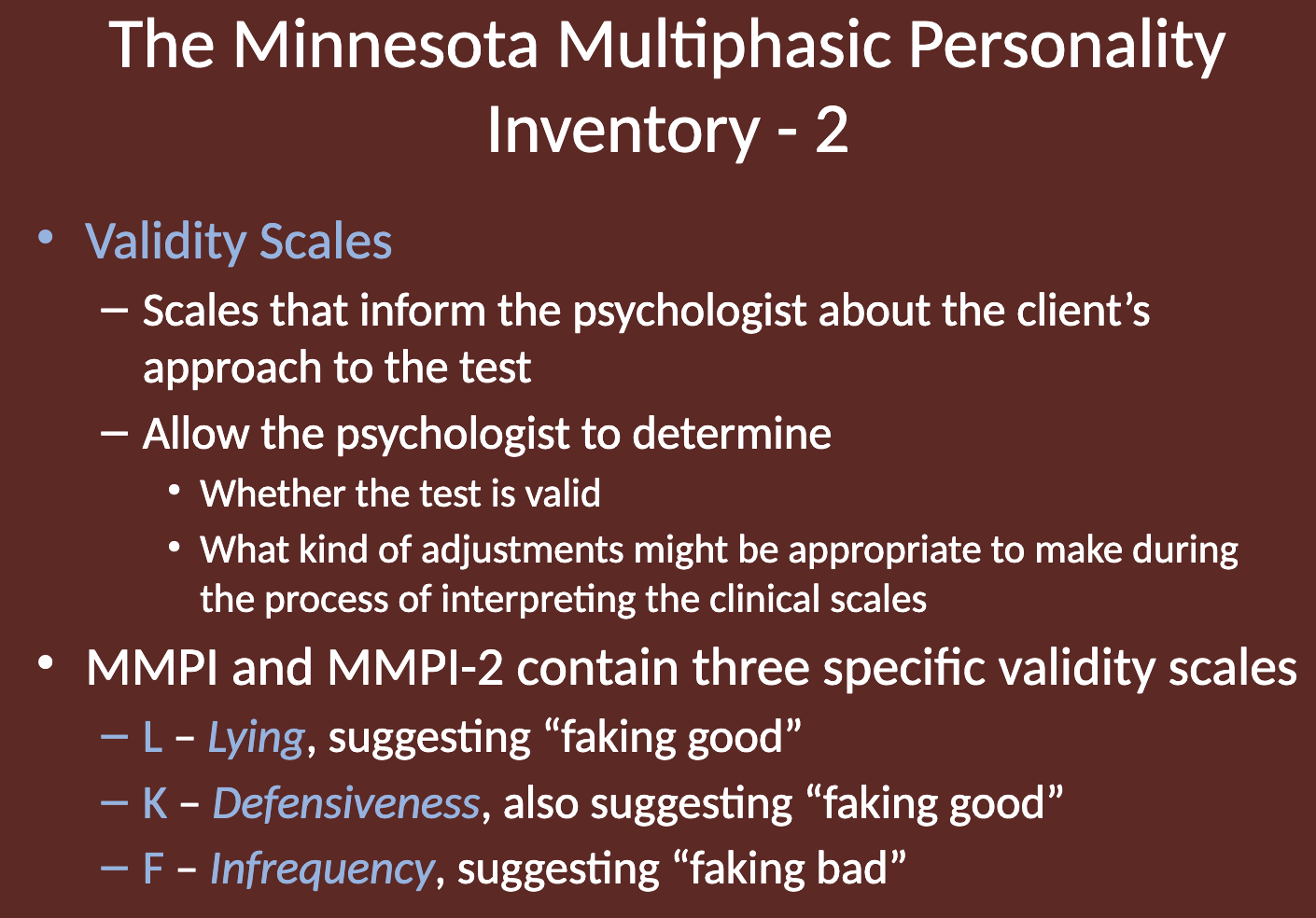
Second Validity Scale: K: Defensiveness (objective: MMPI)
Also suggests "faking good," but by being defensive or overly self-protective.
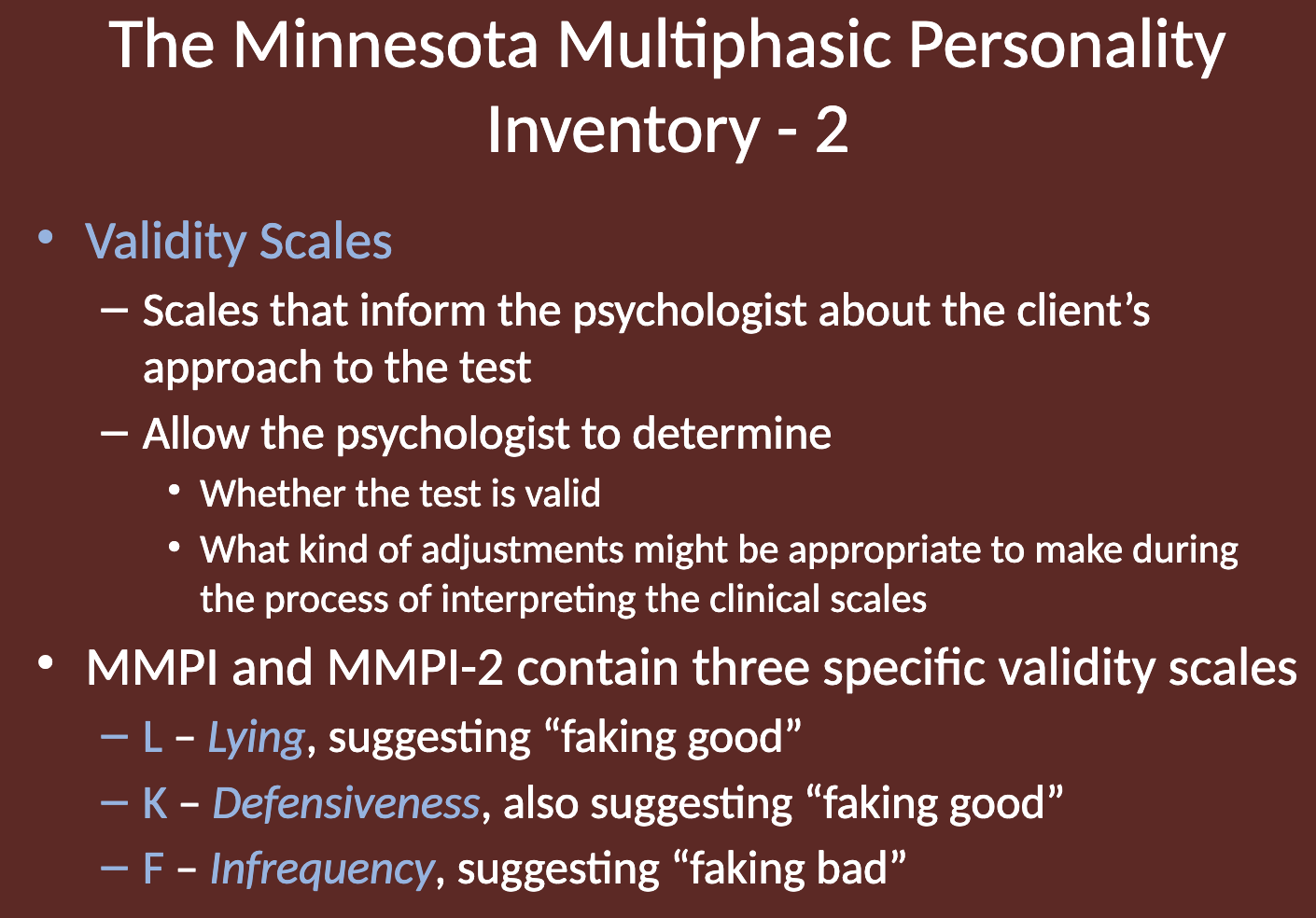
Third Validity Scale: F: Infrequency (objective: MMPI)
Suggests "faking bad," indicating unusual or infrequent responses, often used to exaggerate symptoms.
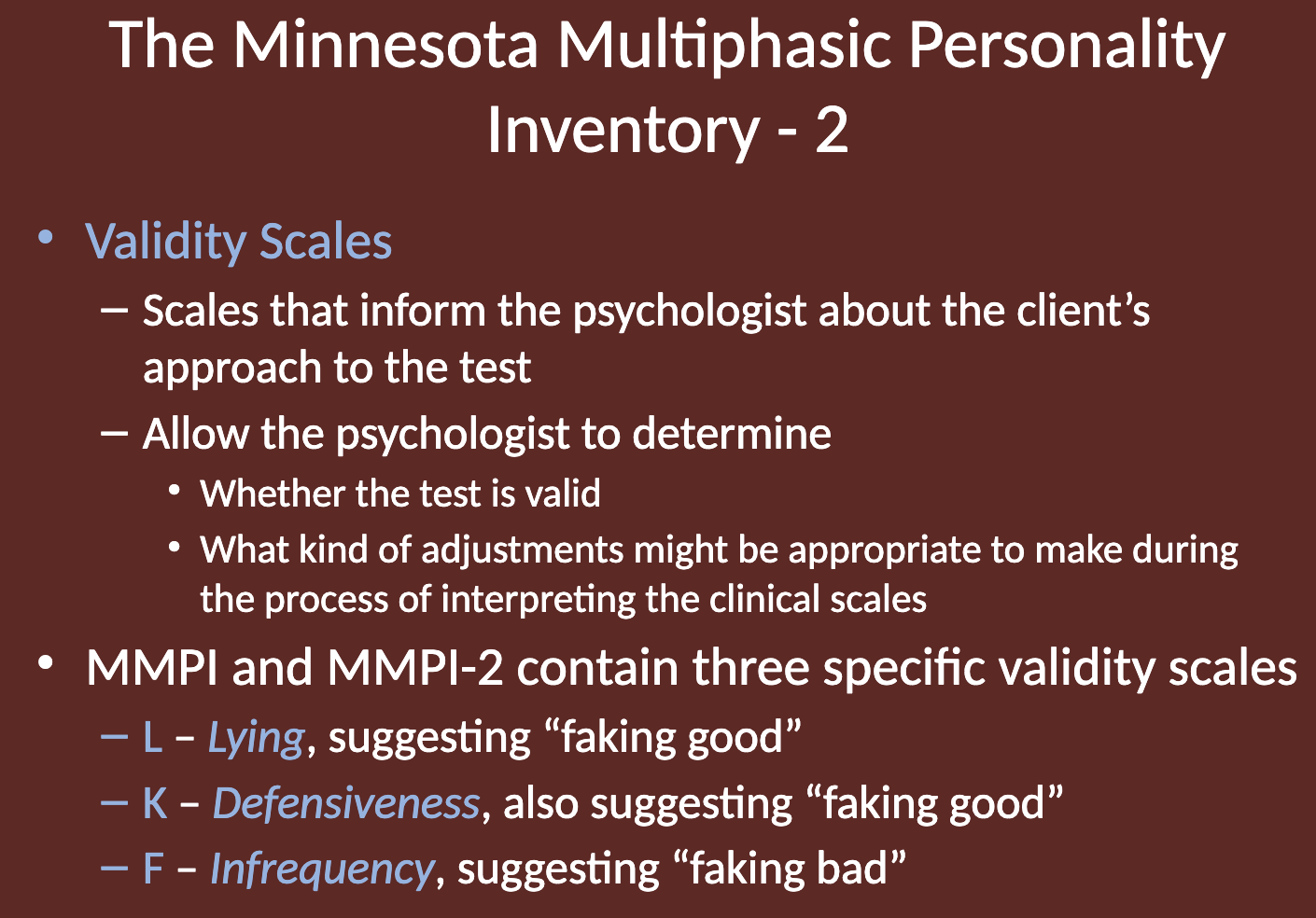
What is the Millon Clinical Multiaxial Inventory - IV (MCMI-IV)? (objective: MCMI IV)
The MCMI-IV is a comprehensive self-report, pencil-and-paper test in a true/false format.
It is designed to assess personality disorders and other forms of personality pathology.
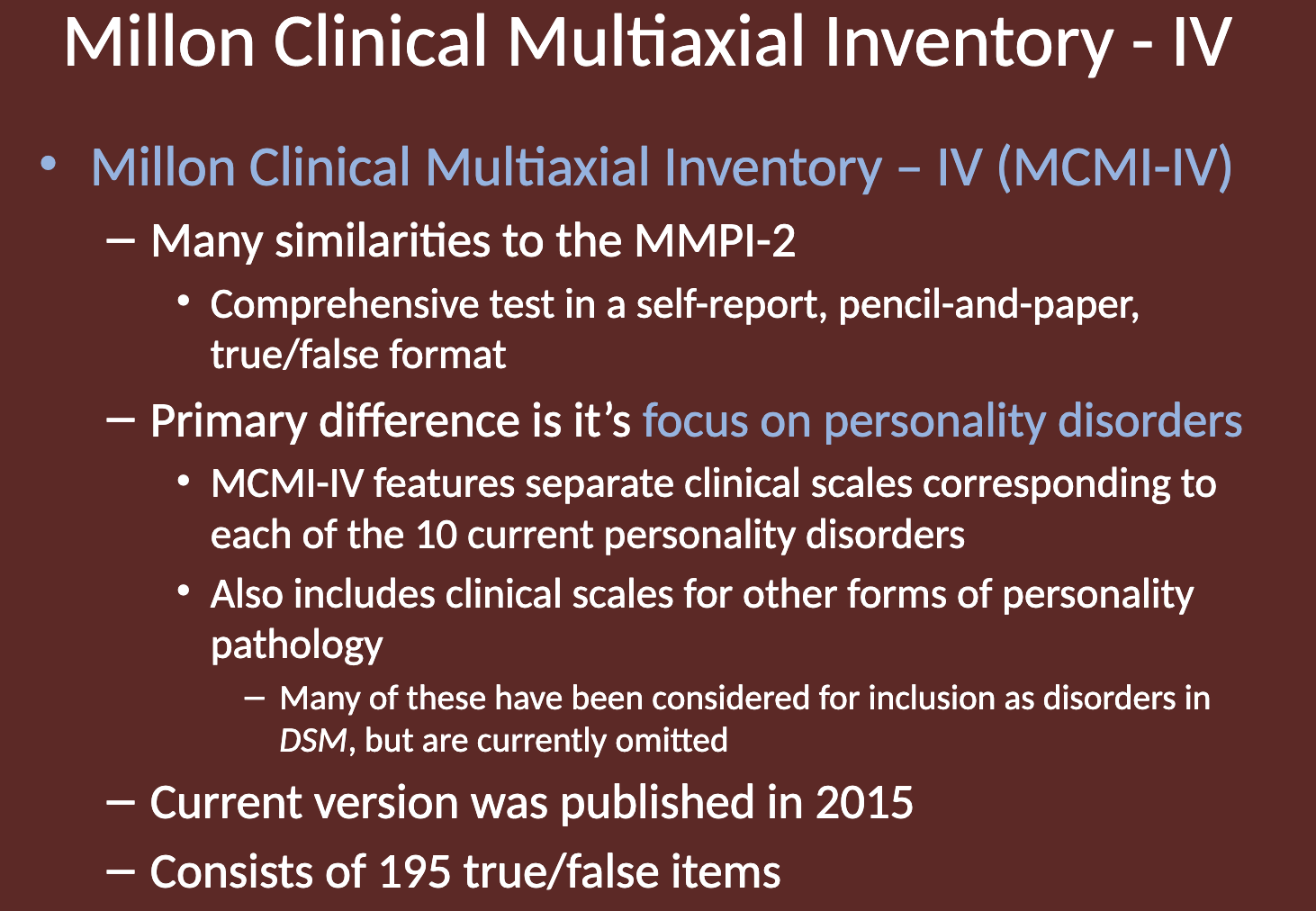
How is the MCMI-IV similar to the MMPI-2? (objective: MCMI IV)
Both the MCMI-IV and MMPI-2 are self-report, paper and pencil tests using a true/false format.
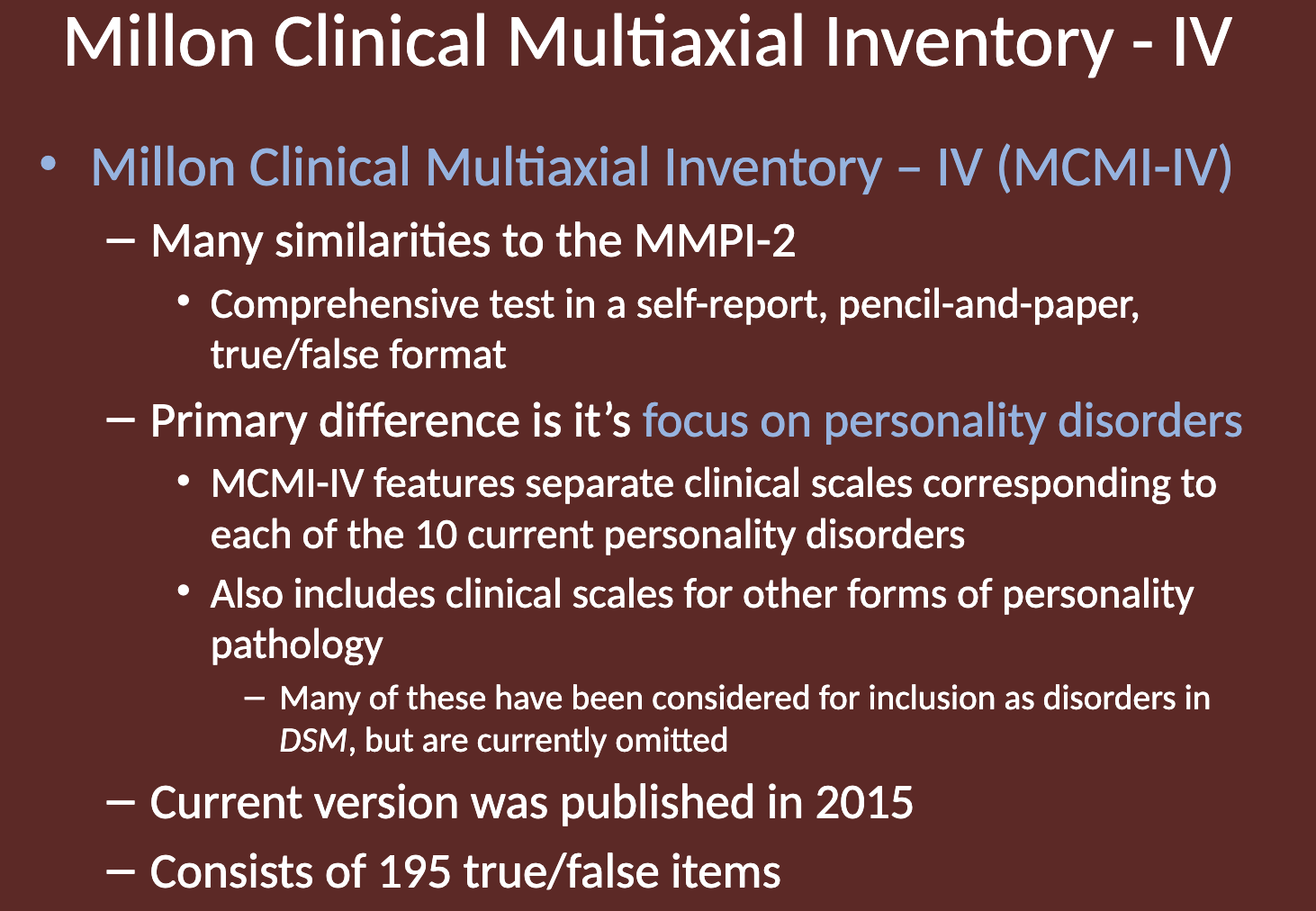
How is the MCMI-IV different from the MMPI-2? (objective: MCMI IV)
The MCMI-IV focuses on personality disorders, with scales corresponding to each of the 10 current personality disorders.
It also includes scales for other forms of personality pathology that are being considered for inclusion in the DSM but are not officially listed as disorders.
The MMPI-2 has a broader focus, including many different psychological conditions, while the MCMI-IV is more specific to personality disorders.
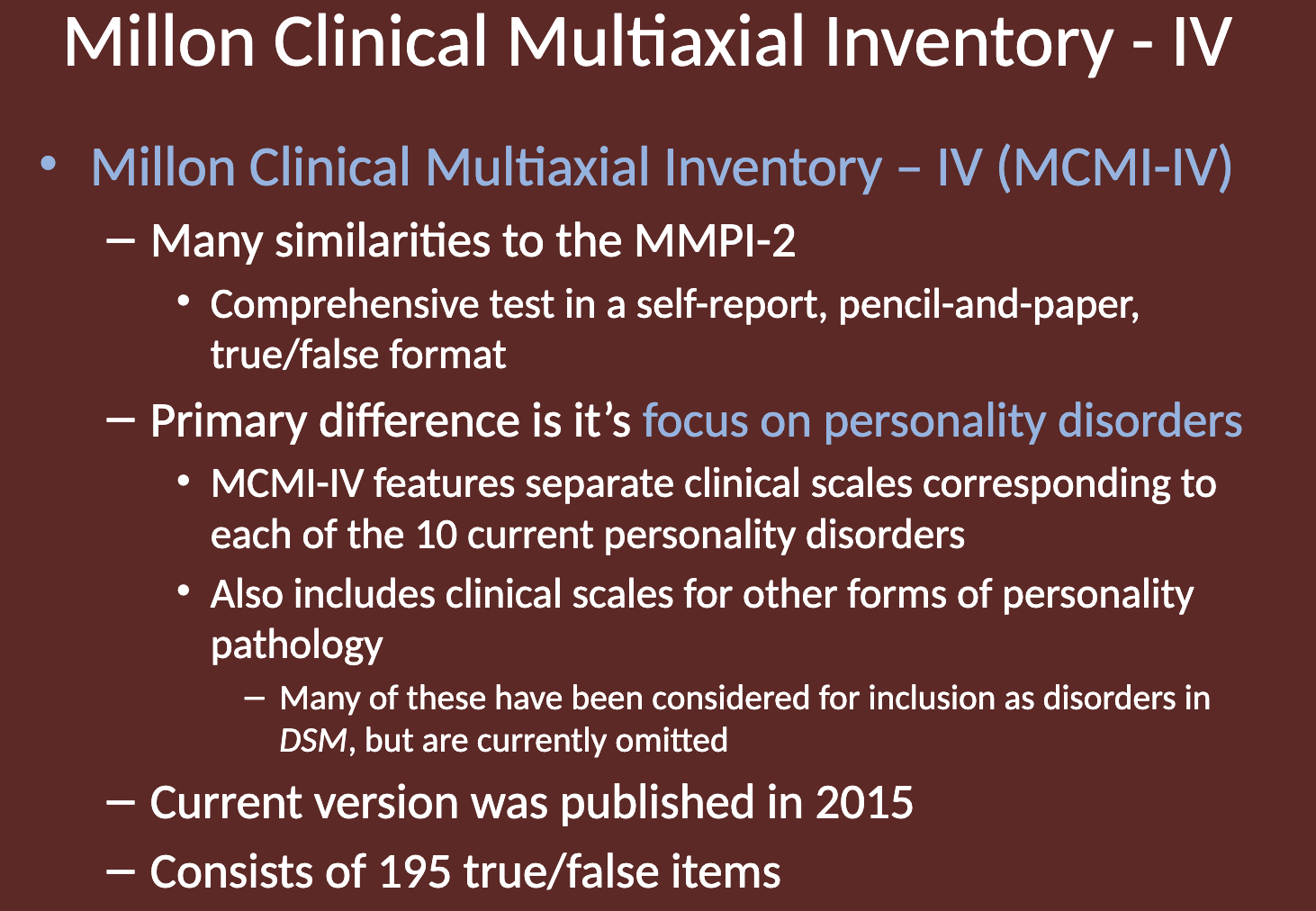
When was the current version of the Millon Clinical Multiaxial Inventory - IV (MCMI-IV) published? (objective: MCMI IV)
The current version of the MCMI-IV was published in 2015. It consists of 195 true/false items.
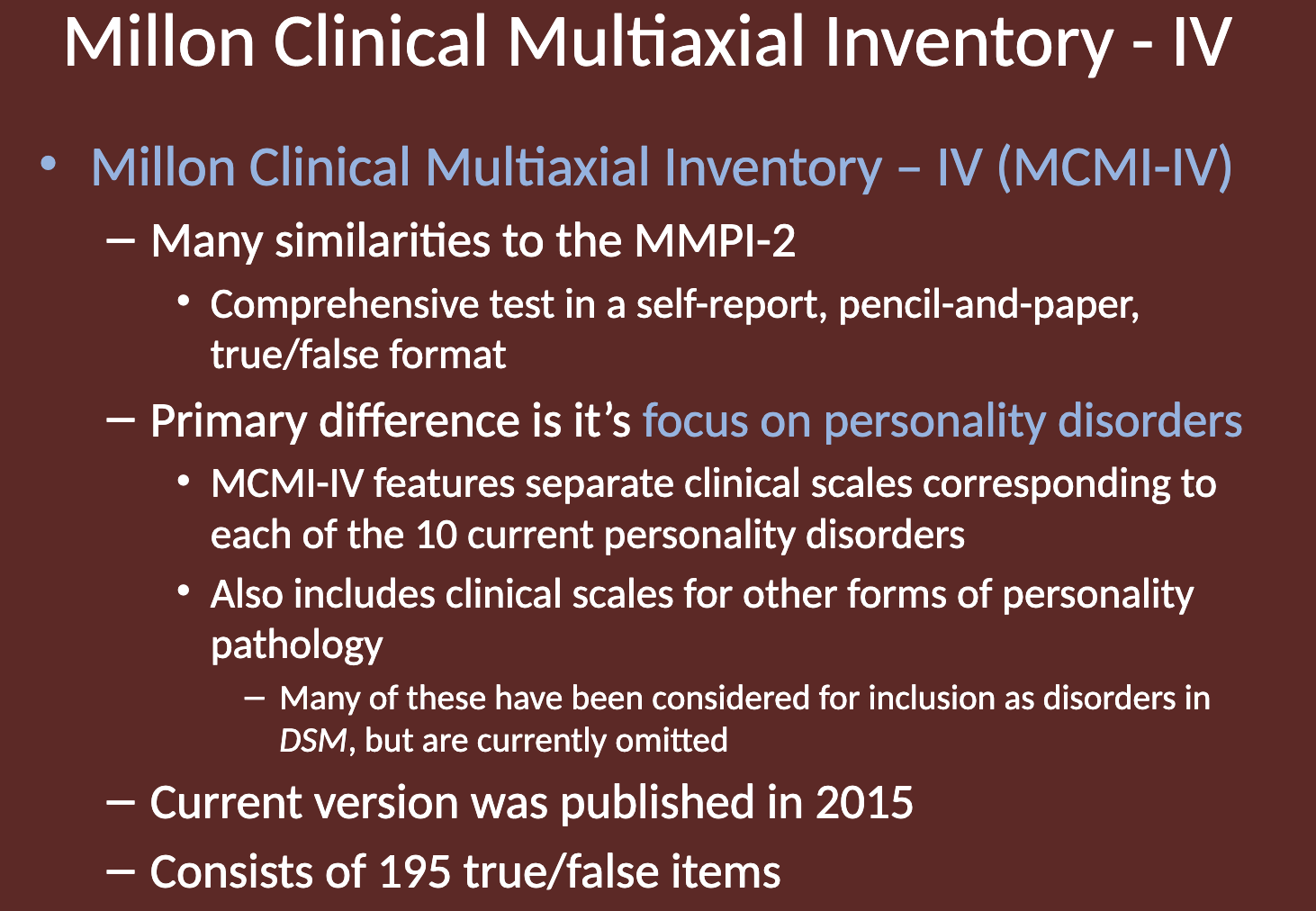
What is the NEO Personality Inventory - Revised (NEO-PI-R)? (objective: NEO)
The NEO-PI-R is a personality assessment tool designed to measure "normal" personality characteristics based on the five-factor model of personality.
Who created the NEO Personality Inventory - Revised (NEO-PI-R) and why? (objective: NEO)
The NEO-PI-R was created by Paul Costa and Robert McCrae.
They sought to develop a personality measure that assesses “normal” personality traits based on the five-factor model.
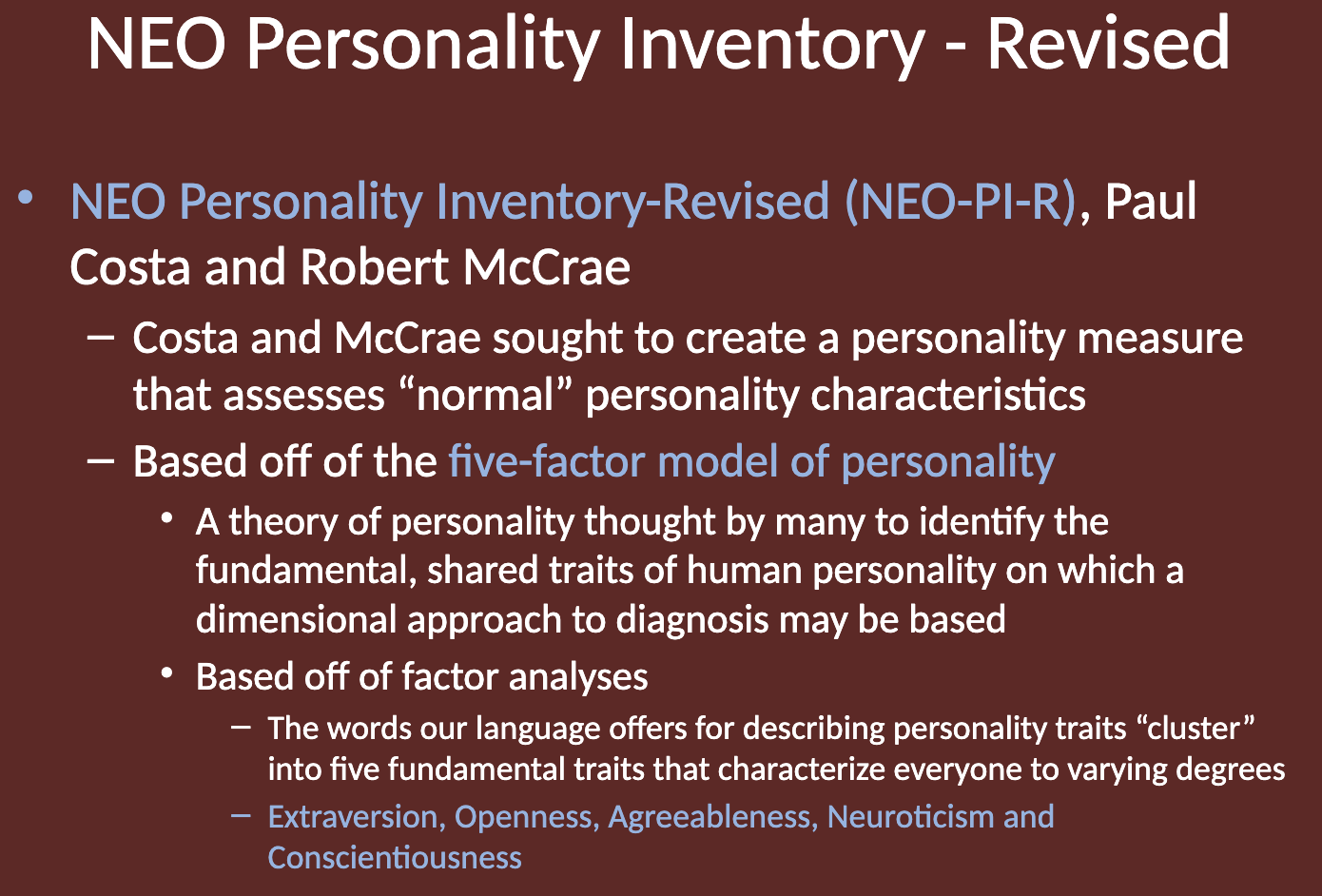
What is the NEO Personality Inventory - Revised (NEO-PI-R) based on? (objective: NEO)
Based off of the five-factor model of personality
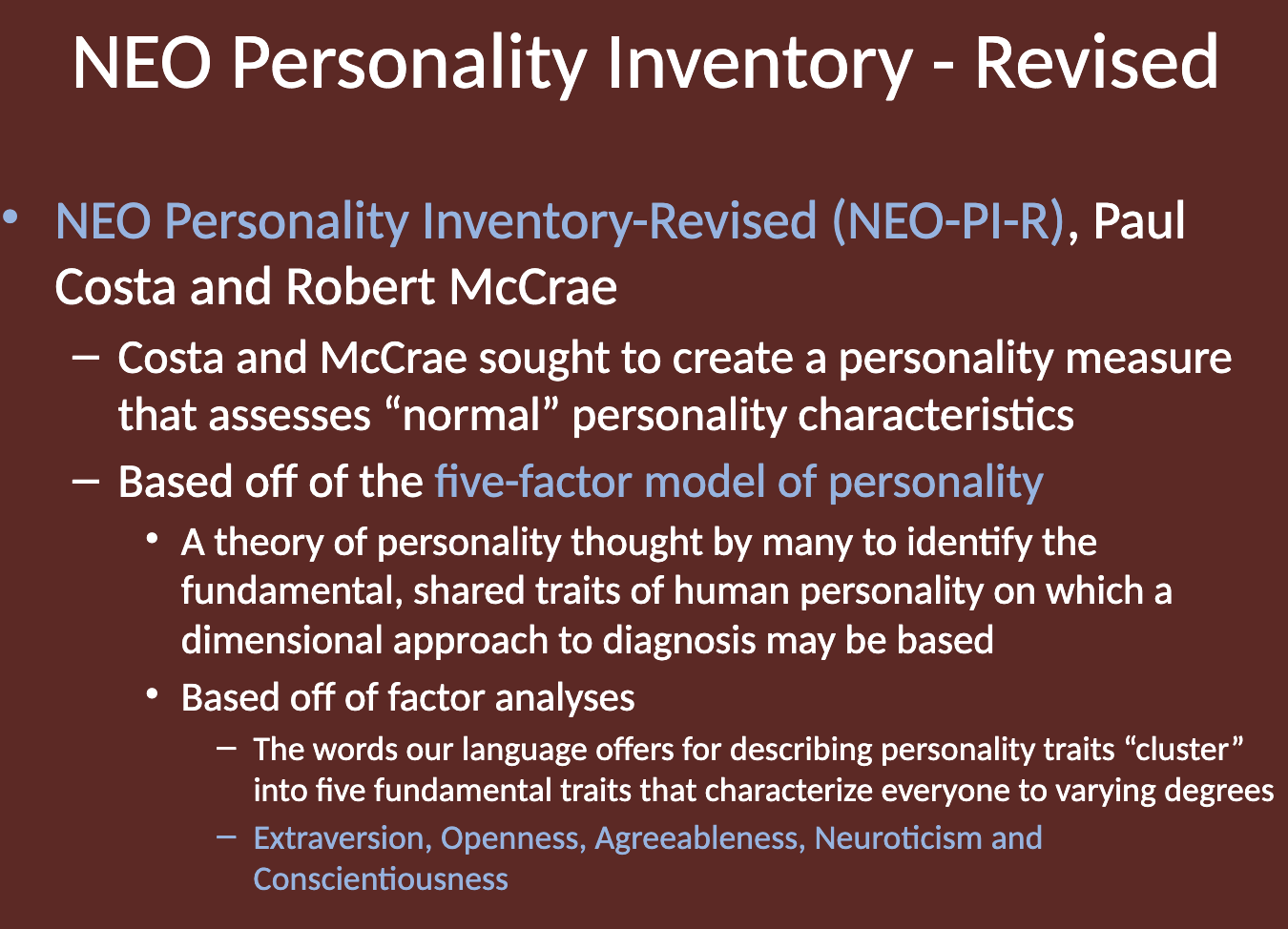
What is the Five-Factor Model of Personality? (objective: NEO)
The NEO is based on it. A theory of personality thought by many to identify the fundamental, shared traits of human personality on which a dimensional approach to diagnosis may be based.
It is based off of factor analysis.
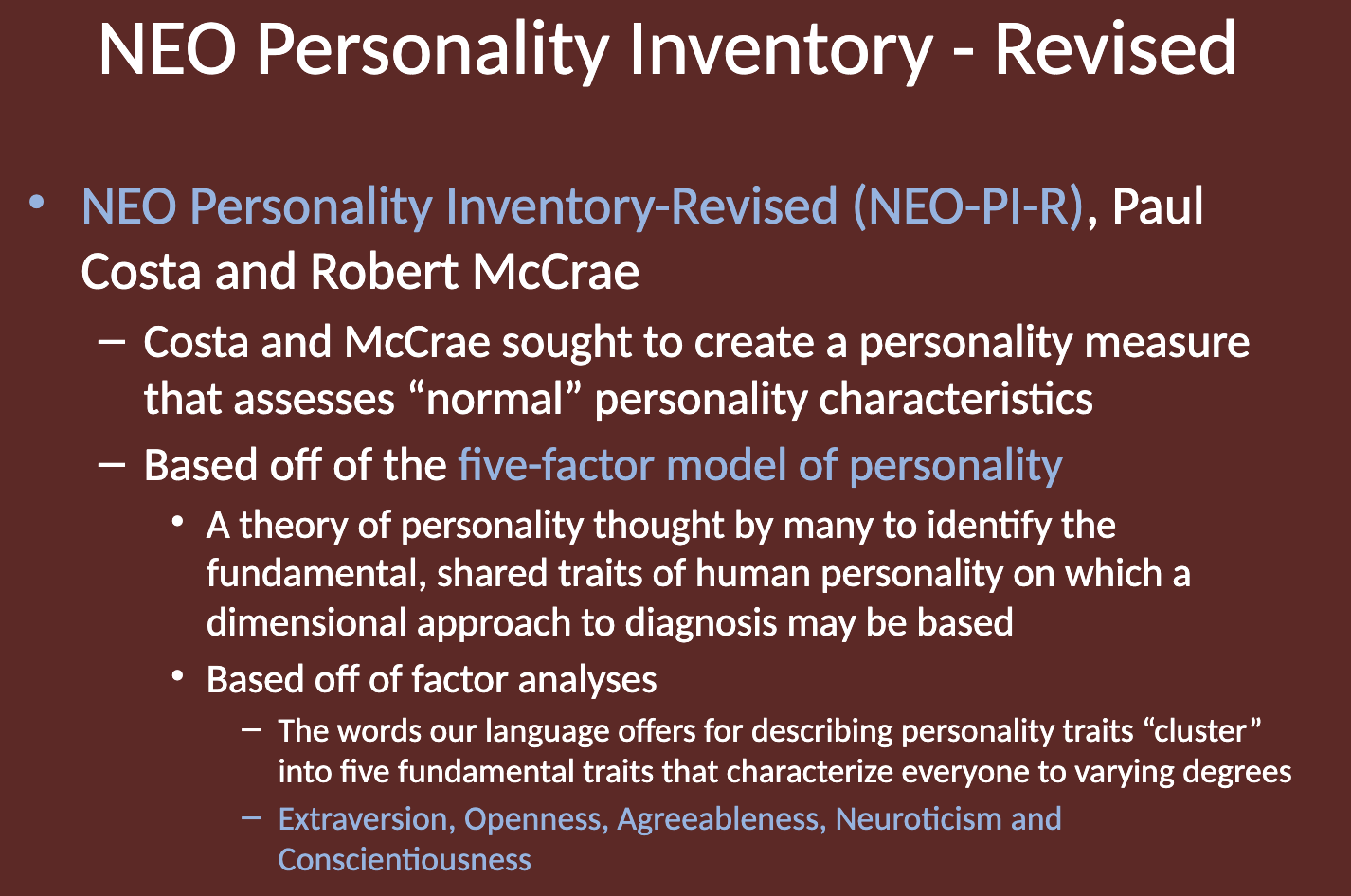
What is the NEO Personality Inventory - Revised (NEO-PI-R) based on? (objective: NEO)
The NEO-PI-R is based on factor analyses, where words used to describe personality traits "cluster" into five fundamental traits. These traits are thought to represent the core dimensions of human personality.
C A N O E
Extraversion, Openness, Agreeableness, Neuroticism and Conscientiousness
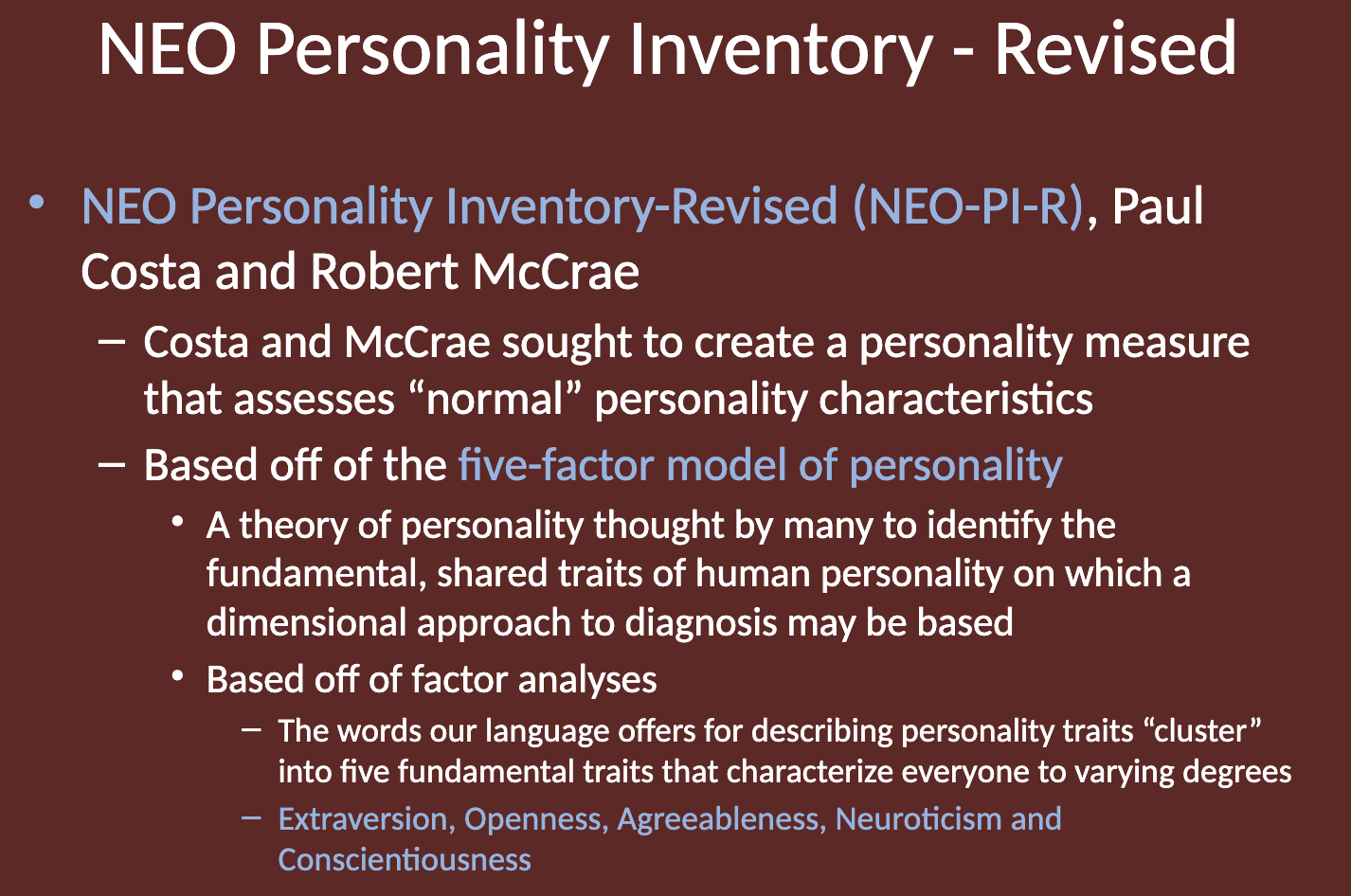
What is the key difference between objective personality tests and projective personality tests? (objective v projective)
Objective Personality Tests: Based on the assumption that personality is best assessed by directly asking people to describe themselves (e.g., true/false or multiple-choice questions).
Projective Personality Tests: Based on the assumption that people will "project" their personalities when presented with unstructured, ambiguous stimuli and an unrestricted opportunity to respond. This allows for deeper exploration of unconscious aspects of personality.
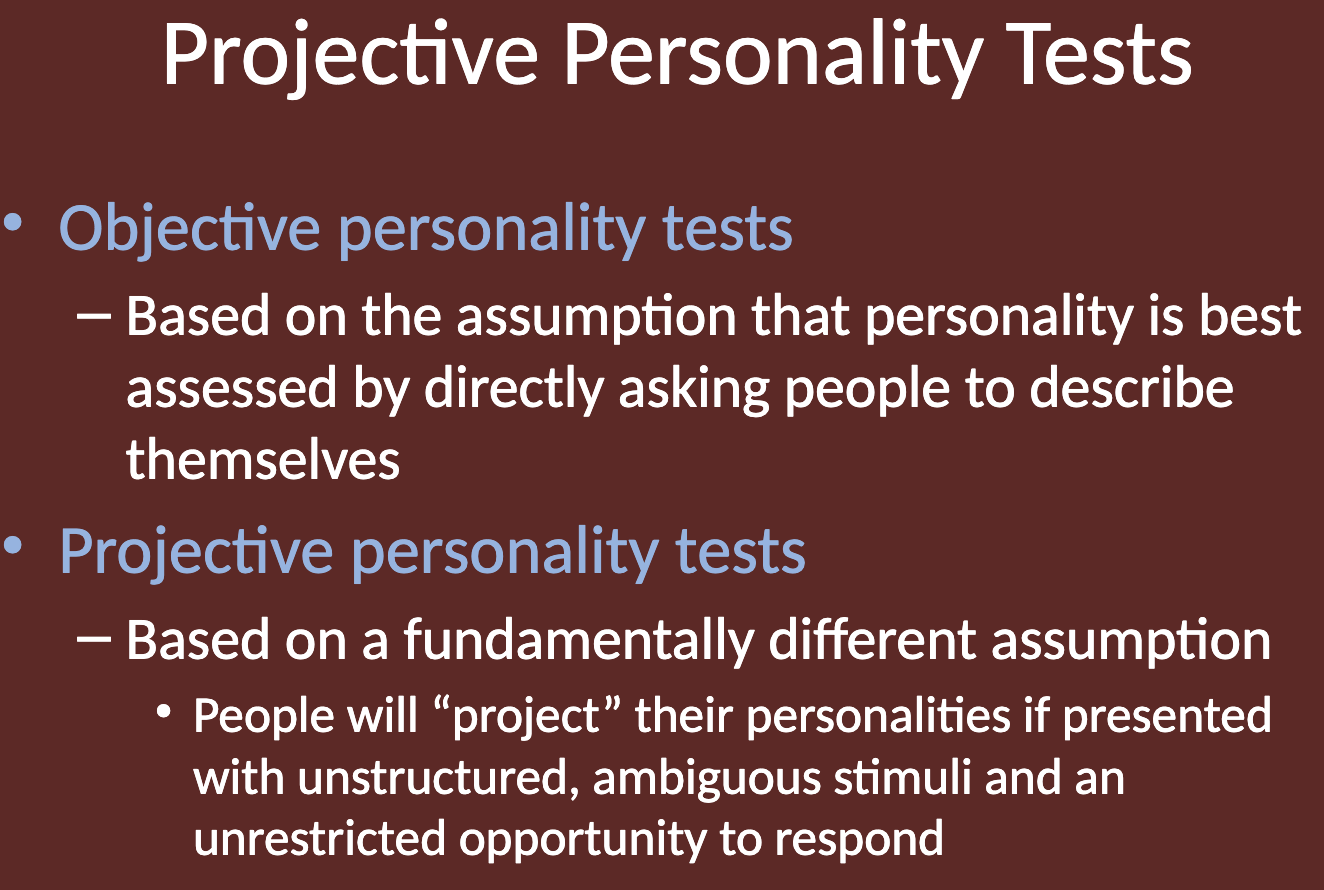
How do projective personality tests work, and what tradition are they mostly associated with? (projective)
Analogy: Projective tests are like a series of "clouds"—ambiguous stimuli displayed to clients, allowing them to interpret the images in any way they choose.
Clients are not restricted to multiple choice or true/false questions.
Responses are often compared with those of others in a normative group.
Psychologists form hypotheses about a client’s personality based on how they respond to the stimuli.
These tests are mostly associated with the psychoanalytic tradition.
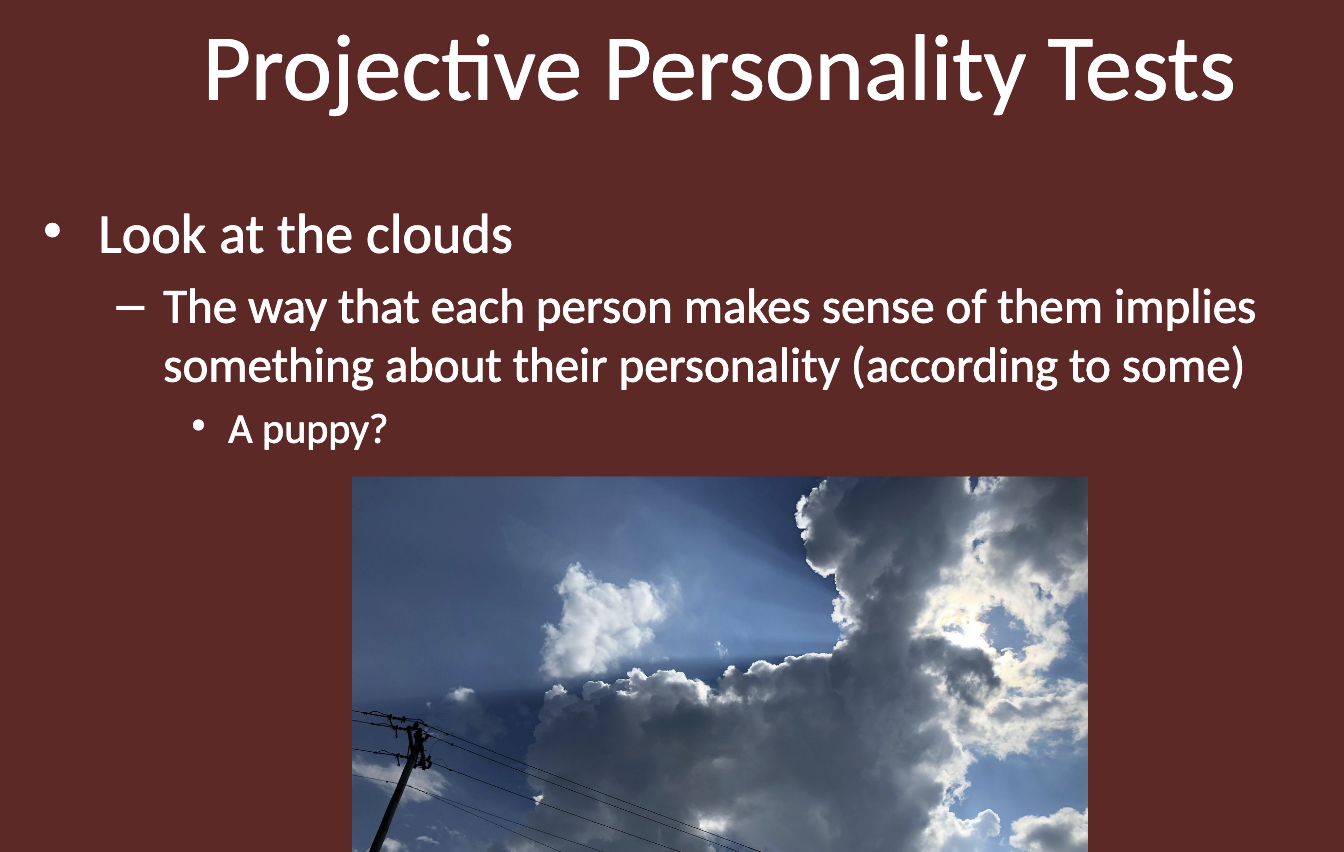
What are the most frequently cited criticisms of projective personality tests? (projective)
Lack of objectivity in scoring and interpreting responses.
Critics argue that projective tests are too inferential and not empirically sound.
Scoring and interpretation rely heavily on a psychologist’s unique methods, which can vary across practitioners.
How do objective tests differ from projective tests in terms of standardization? (projective)
Objective Tests: Responses are typically true/false statements with standardized scoring and consistent interpretation.
Projective Tests: Clients give unique responses, and scoring may vary across psychologists. Once responses are scored, the process of assigning meaning is less systematic and more idiosyncratic.

Why has the standing of projective personality tests declined? (projective)
The validity and reliability of projective tests are considered insufficient to justify their use.
Critics argue that their lack of objectivity in scoring and interpretation makes them less reliable.
Psychologists and graduate programs have increasingly moved away from using and teaching these tests.

What is the Rorschach Inkblot Test? (projective: Rorschach)
The Rorschach Inkblot Test is a projective personality test where individuals are shown 10 inkblots and asked what they see. The responses are believed to reveal aspects of their personality.
5 with only black ink, 5 with multiple colors
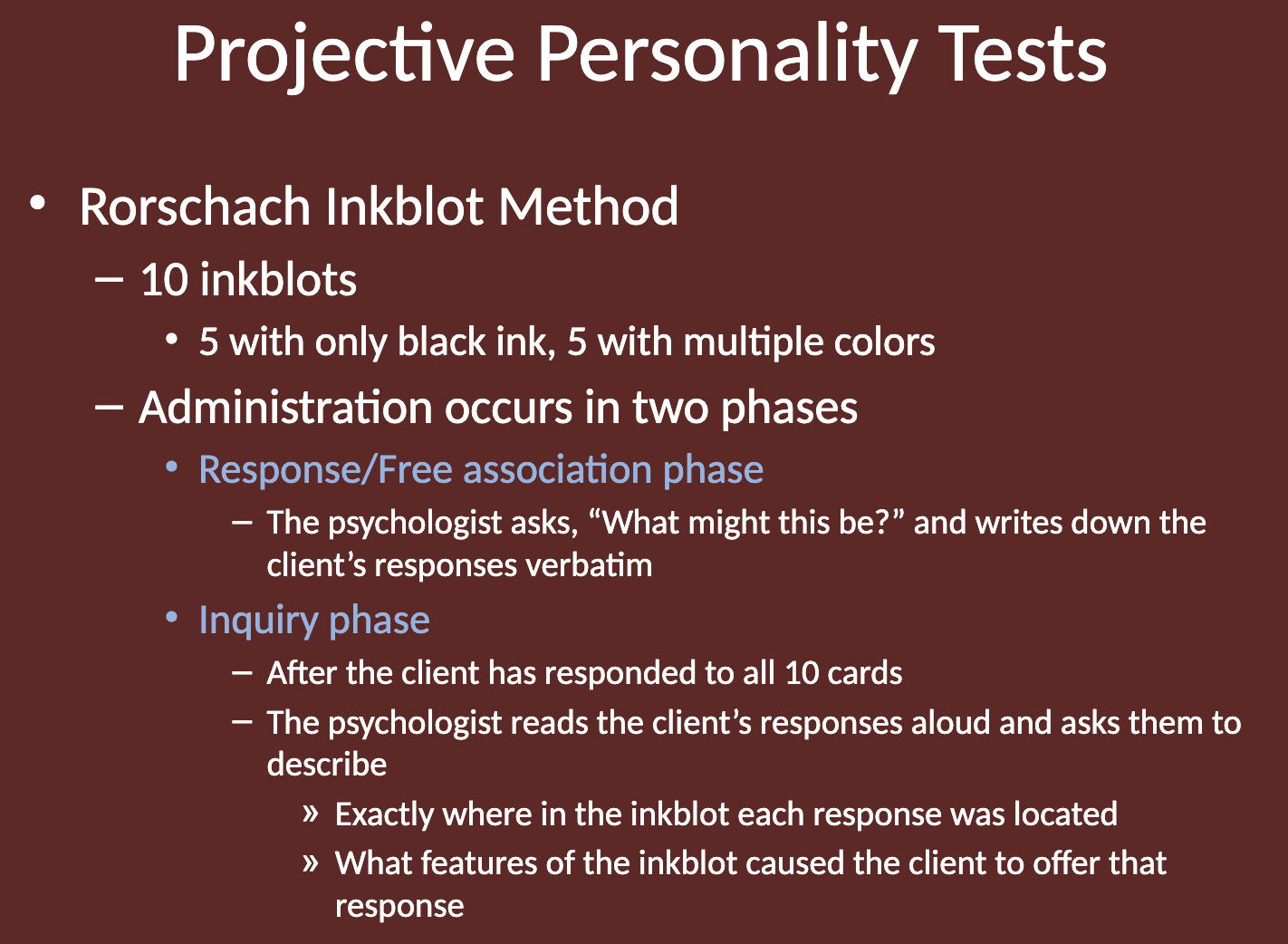
Who created the Rorschach Inkblot Test, and when was it created? (projective: Rorschach)
The Rorschach Inkblot Test was created by Hermann Rorschach in 1921.
Rorschach was inspired by a childhood game of interpreting inkblots and applied this method to his patients, hypothesizing that their responses would reveal personality traits.
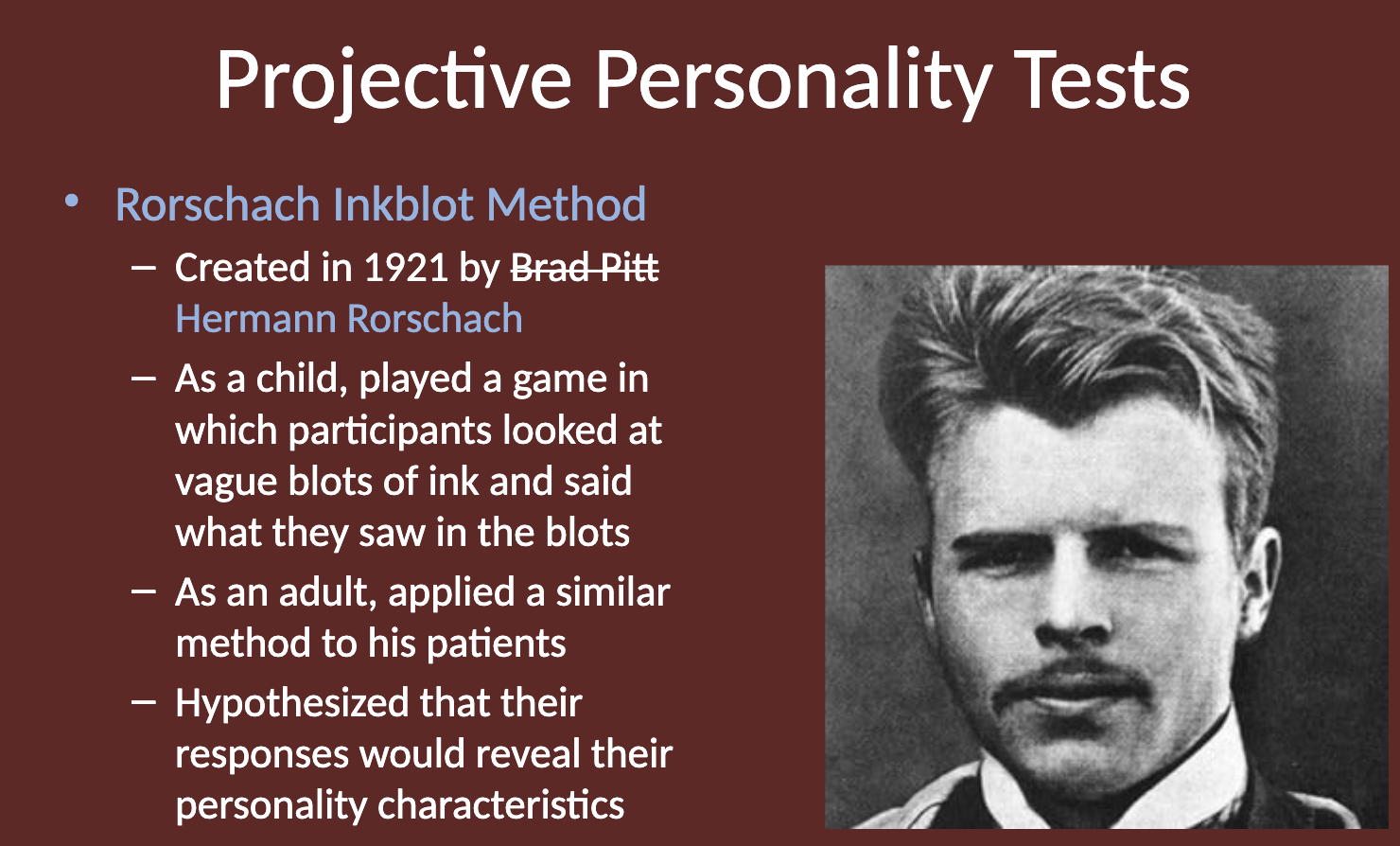
What is the method of the Rorschach Inkblot Test? (projective: Rorschach)
The test involves 10 inkblots (5 in black ink, 5 in multiple colors).
It is administered in two phases:
Response/Free Association Phase: The psychologist asks, "What might this be?" and records the client's verbatim responses.
Inquiry Phase: After all cards have been shown, the psychologist reviews the responses and asks the client to explain where in the inkblot each response was located and what features of the inkblot caused that response.
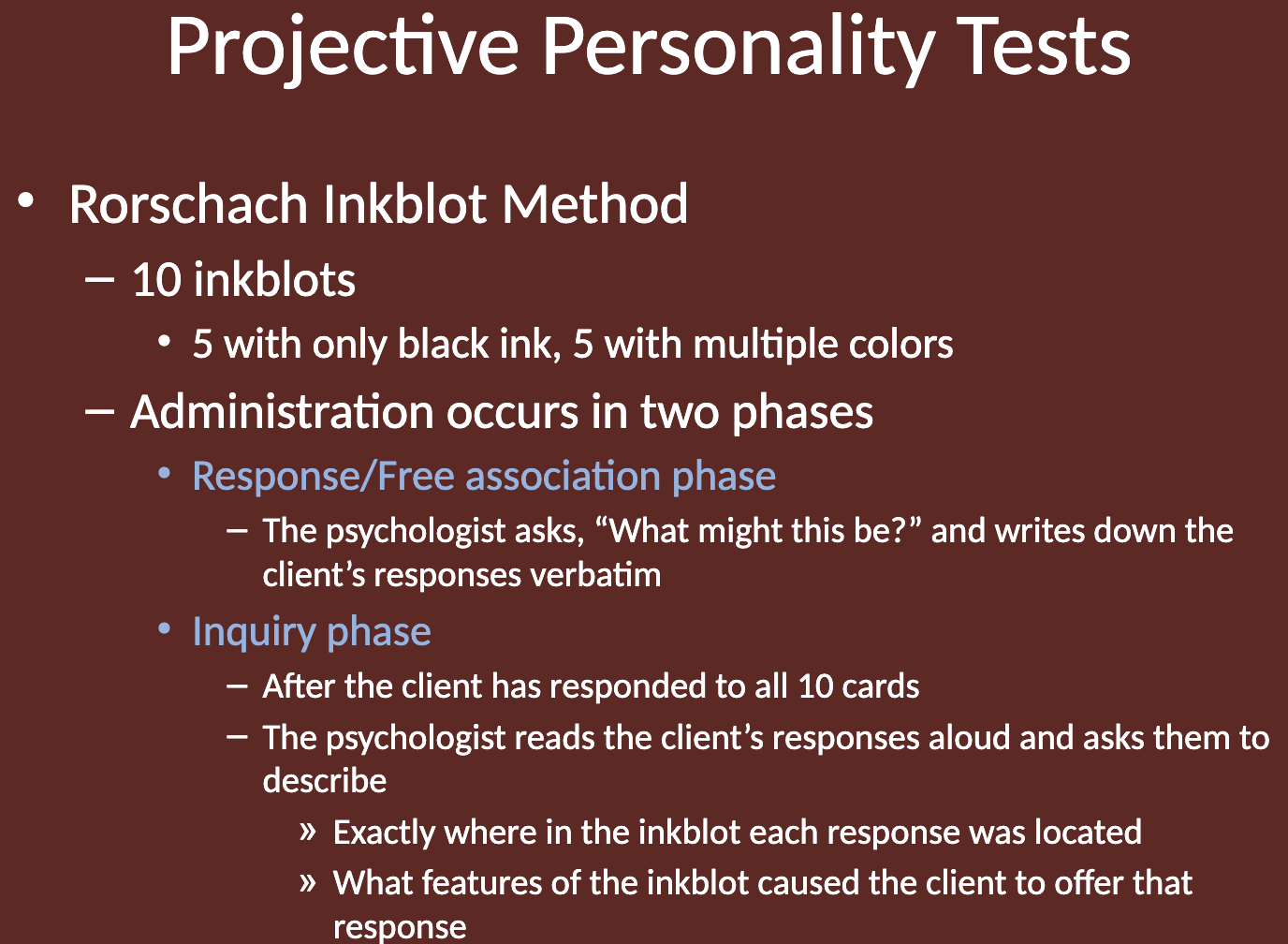
What did Rorschach publish without, and when did he die? (projective: Rorschach)
Rorschach published the inkblots in 1921 without a scoring method. He passed away a year later in 1922.
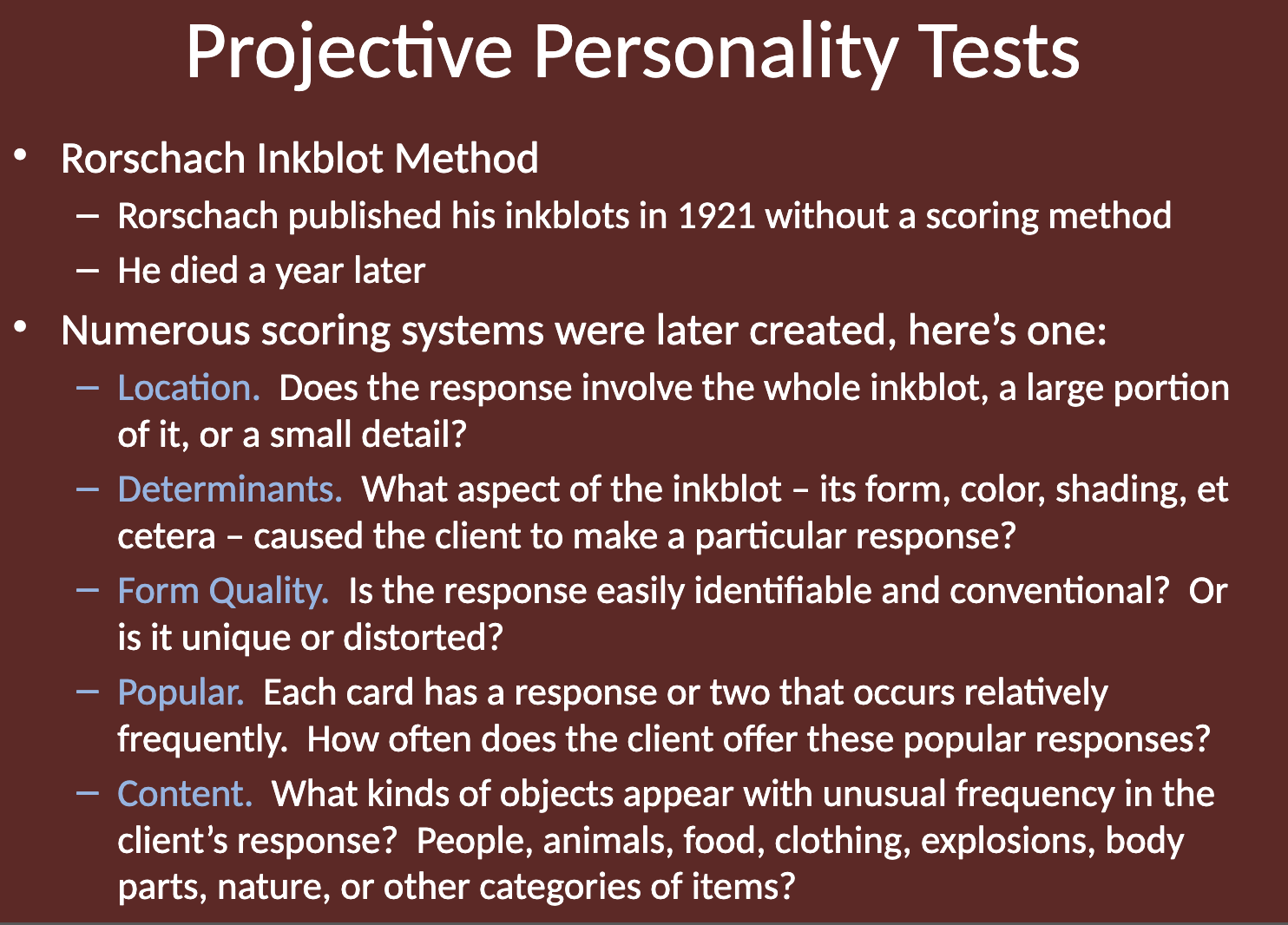
What are the five scoring systems created for the Rorschach Inkblot Test after Rorschach died? (projective: Rorschach)
After Rorschach's death, numerous scoring systems were created for the test. Here are five key systems:
Location
Determinants
Form Quality
Popular
Content
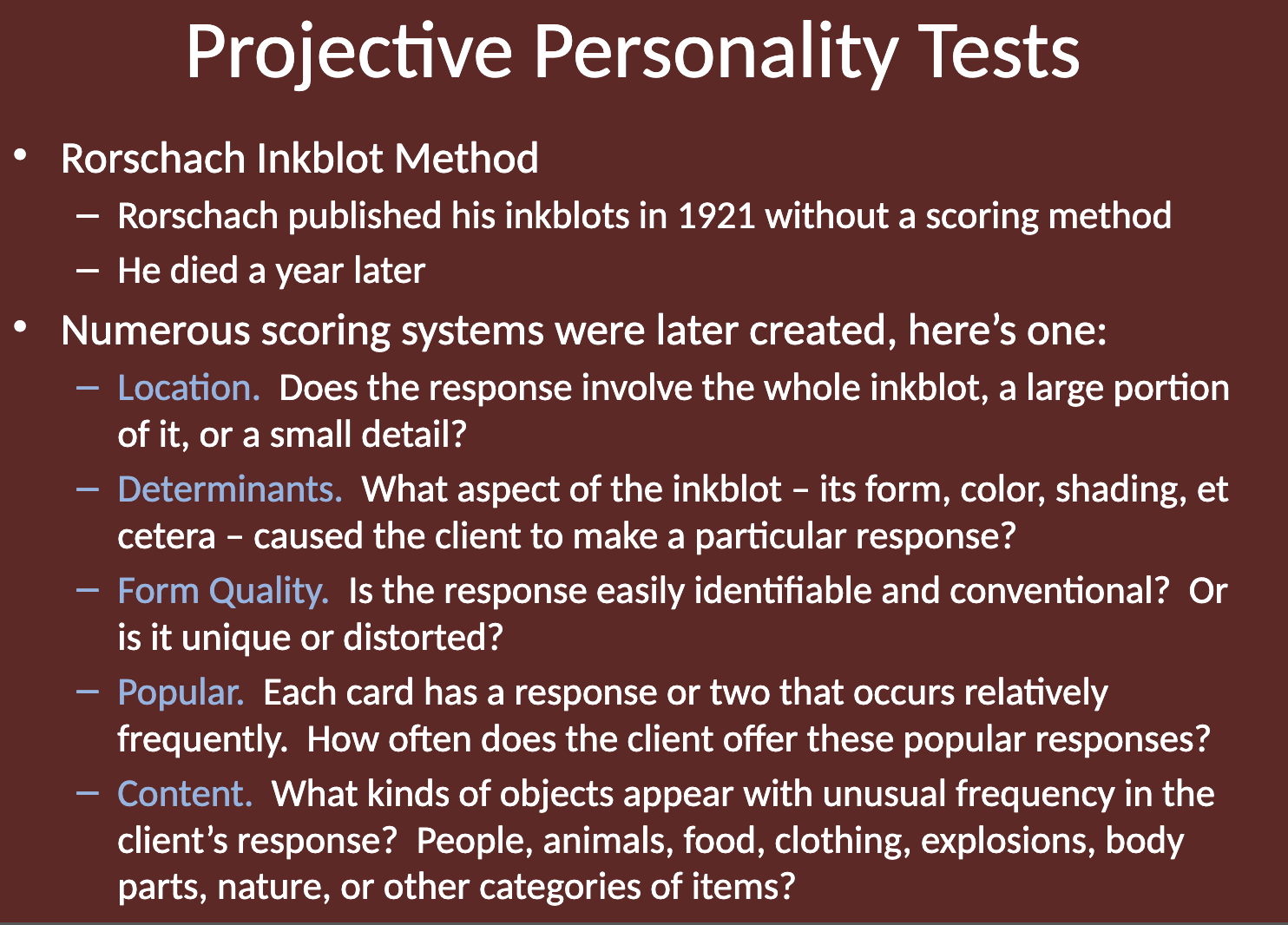
What is the Location scoring system in the Rorschach Inkblot Test? (projective: Rorschach)
The Location system looks at whether the response involves:
The whole inkblot,
A large portion of it, or
A small detail of the inkblot.
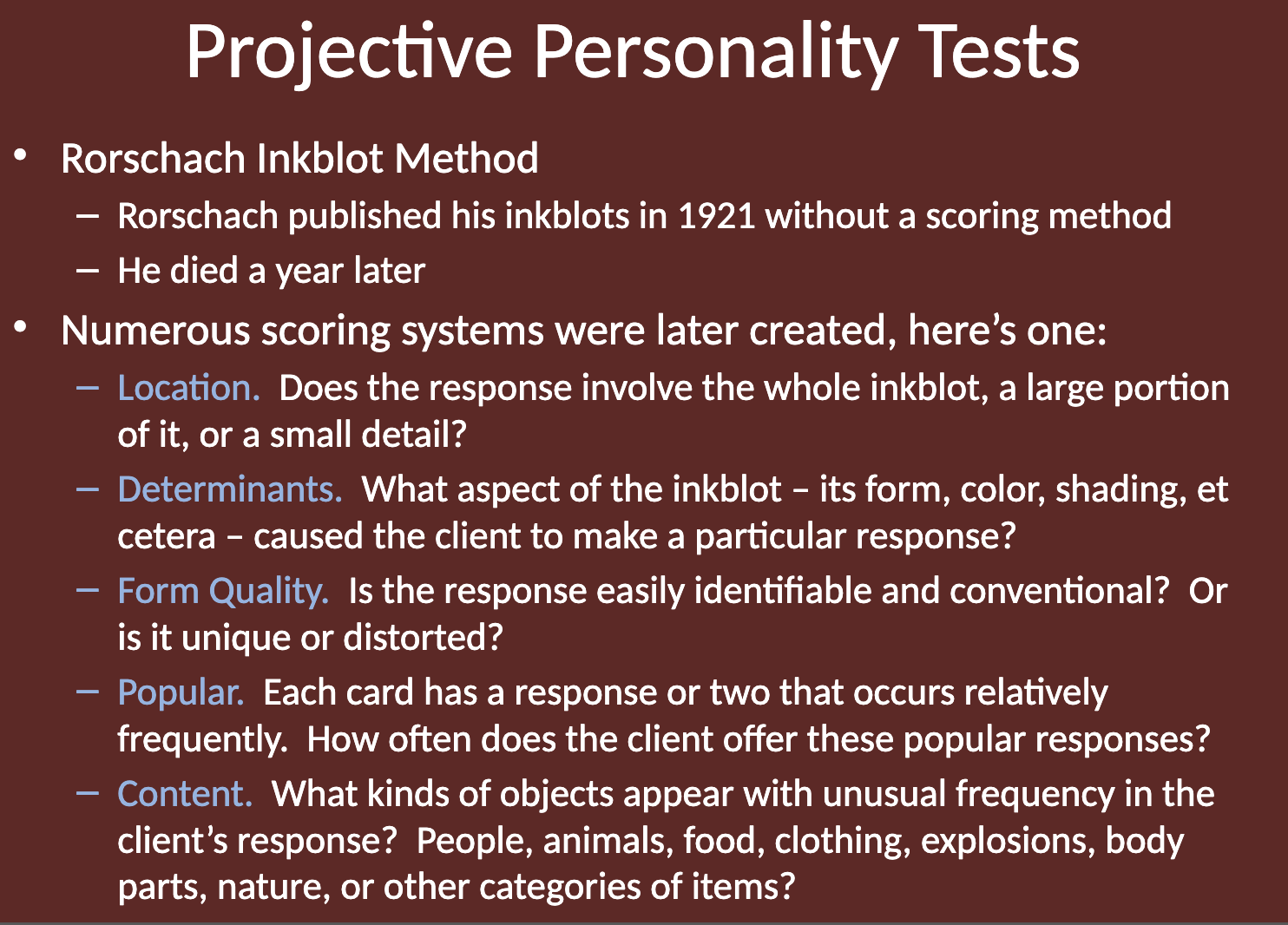
What is the Determinants scoring system in the Rorschach Inkblot Test? (projective: Rorschach)
The Determinants system examines what specific aspect of the inkblot caused the client’s response, such as:
Form,
Color,
Shading, or other features of the inkblot.
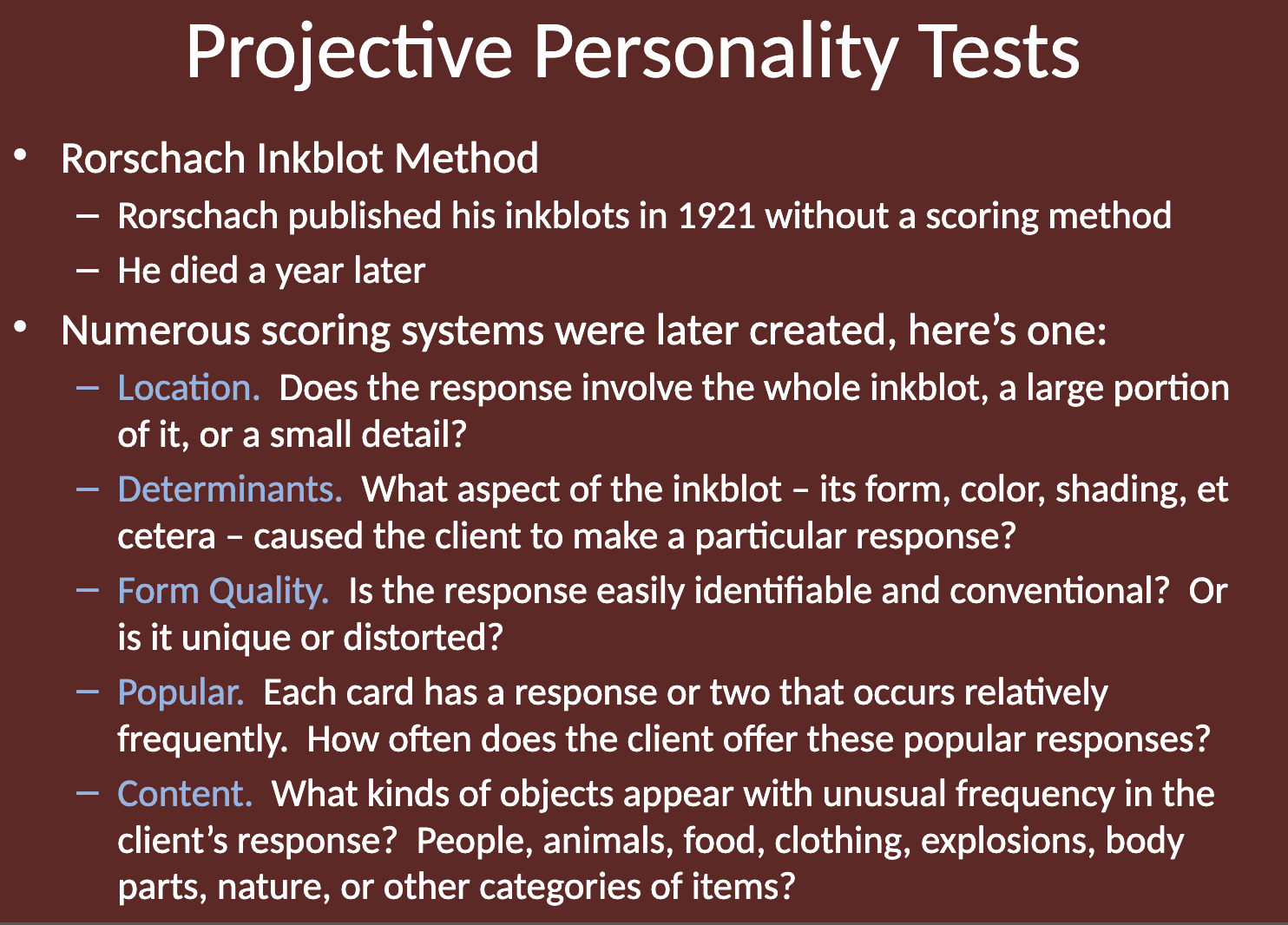
What is the Form Quality scoring system in the Rorschach Inkblot Test? (projective: Rorschach)
The Form Quality system assesses whether the client’s response is:
Easily identifiable and conventional, or
Unique or distorted.
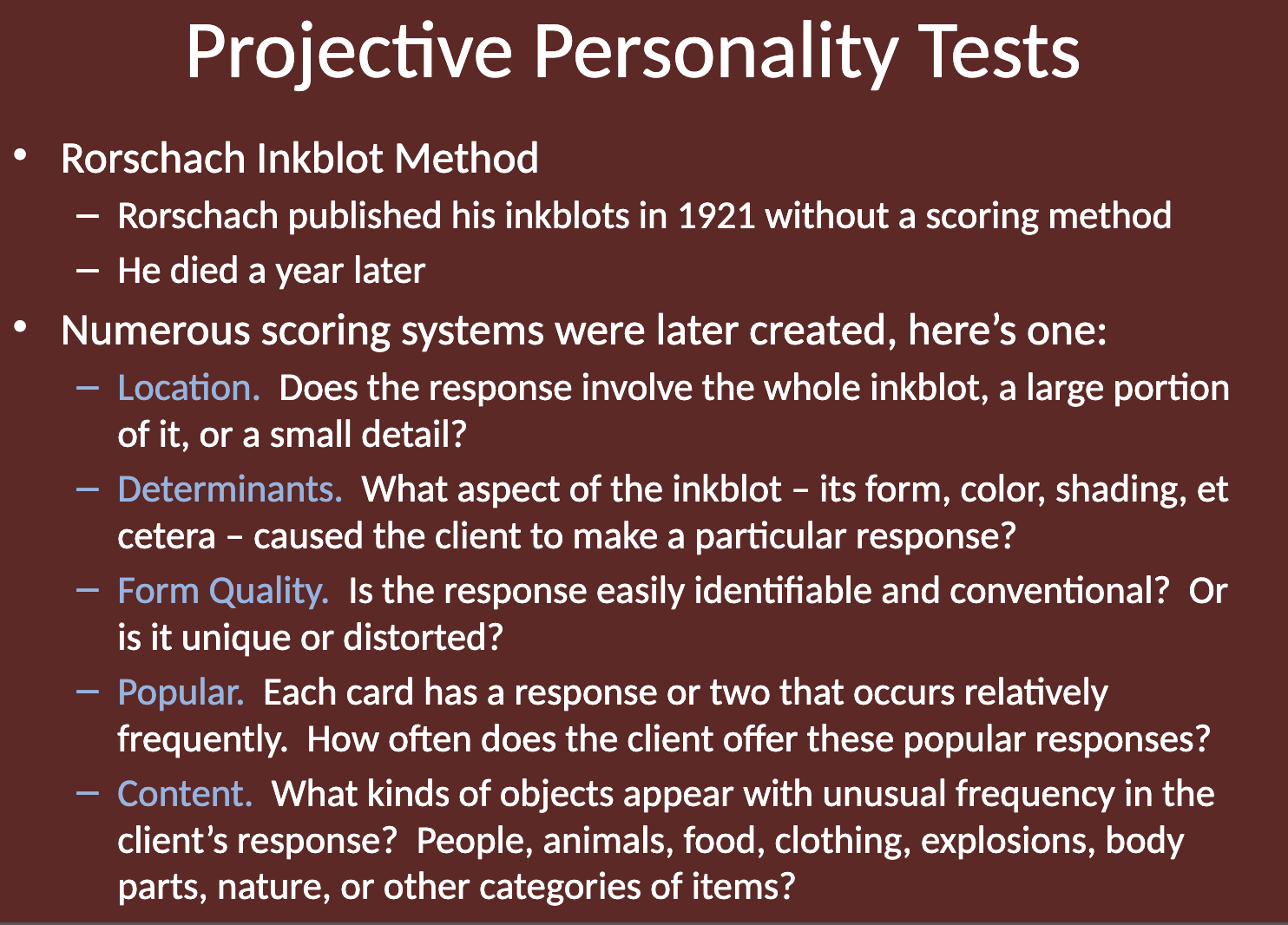
What is the Popular scoring system in the Rorschach Inkblot Test? (projective: Rorschach)
The Popular system looks at how frequently the client gives responses that are common or frequent for each card (responses that appear often in a normative group).
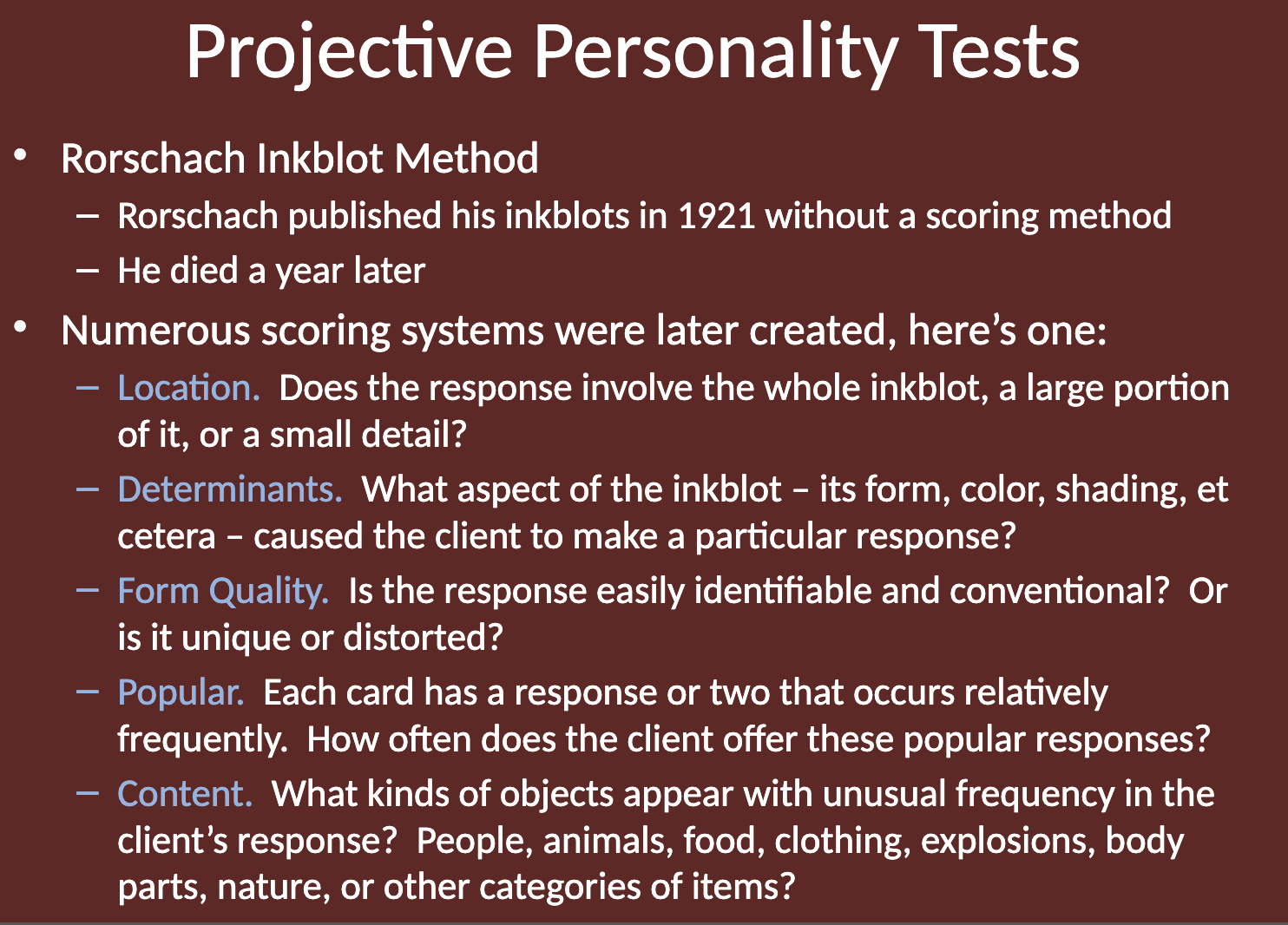
What is the Content scoring system in the Rorschach Inkblot Test? (projective: Rorschach)
The Content system examines what types of objects appear in the client’s responses, such as:
People,
Animals,
Food,
Clothing,
Nature, or other categories.
It focuses on identifying patterns or unusual frequency of specific content.
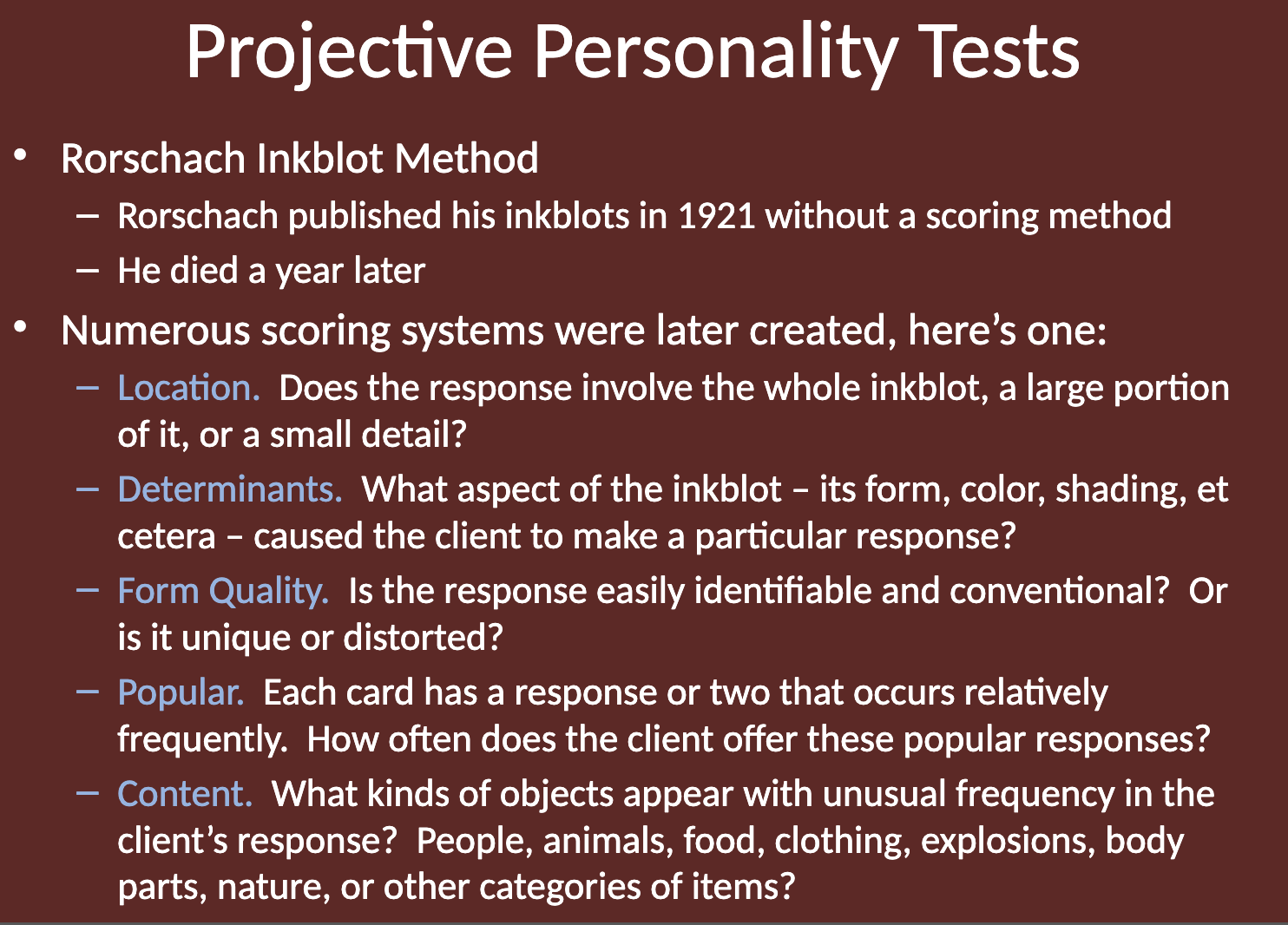
What is the Thematic Apperception Test (TAT)? (projective: TAT)
The Thematic Apperception Test (TAT) was published by Henry Murray and Christiana Morgan. It involves presenting the client with a series of cards, each featuring an ambiguous stimulus.
The cards depict interpersonal scenes, and the client's task is to create a story for each scene.
They are asked to describe what happened before, what may happen next, and what the characters might be thinking and feeling.
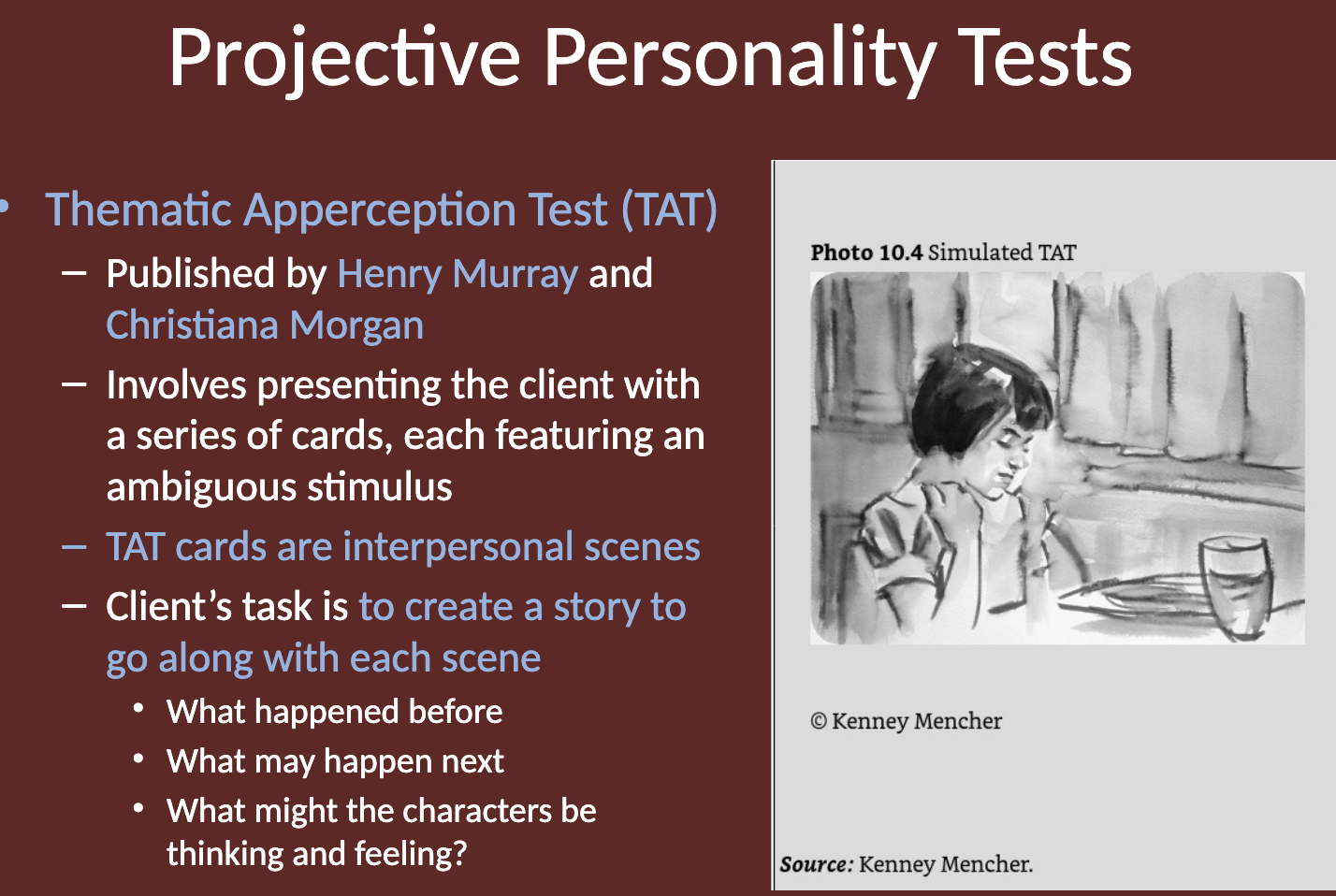
TAT cards are ___ scenes. (projective: TAT)
interpersonal
What are some examples of simulated responses for the Thematic Apperception Test (TAT)? (projective: stim TAT)
"She’s really nervous about something. It’s only breakfast time, but she’s already anxious about something coming up during her day. Maybe she’s worrying about a test at school, or some kids who might tease her, or the school bus getting into an accident, or something happening out of the blue that she hasn’t even thought about yet. Not sure which, but she’s definitely worried about something, and she’s only gonna get more worried as the day goes on."
"She is a sad, sad girl. She’s looking at that plate and thinking that it’s empty, just like her life. Something good may appear on the plate soon, but that will only be temporary. It’s just like her life – she wishes she could stay happy, but she just can’t. No matter what, she ends up sad again."
"She’s excited for a family dinner. Soon, her parents and brothers and sisters will be around the table, and there will be eating and laughing, and fun. Then, they will all help clean up and have a great evening. As she goes to bed, she’ll be looking forward to another great day tomorrow."
"She’s a guest at this house – her friend invited her to have dinner over. She’s thinking about the jewelry she just stole from her friend’s mother’s bedroom. She snuck in there when no one was looking and grabbed some earrings and a necklace. Some people would be feeling guilty about it, but she doesn’t – not at all. She actually gets a rush out of it."
What are sentence completion tasks in projective personality tests? (projective: sentence)
Sentence completion tasks assume that clients’ personalities are revealed by the endings they add and the sentences they create. These tasks involve presenting clients with incomplete sentences, and the responses are analyzed to gain insights into their personality.
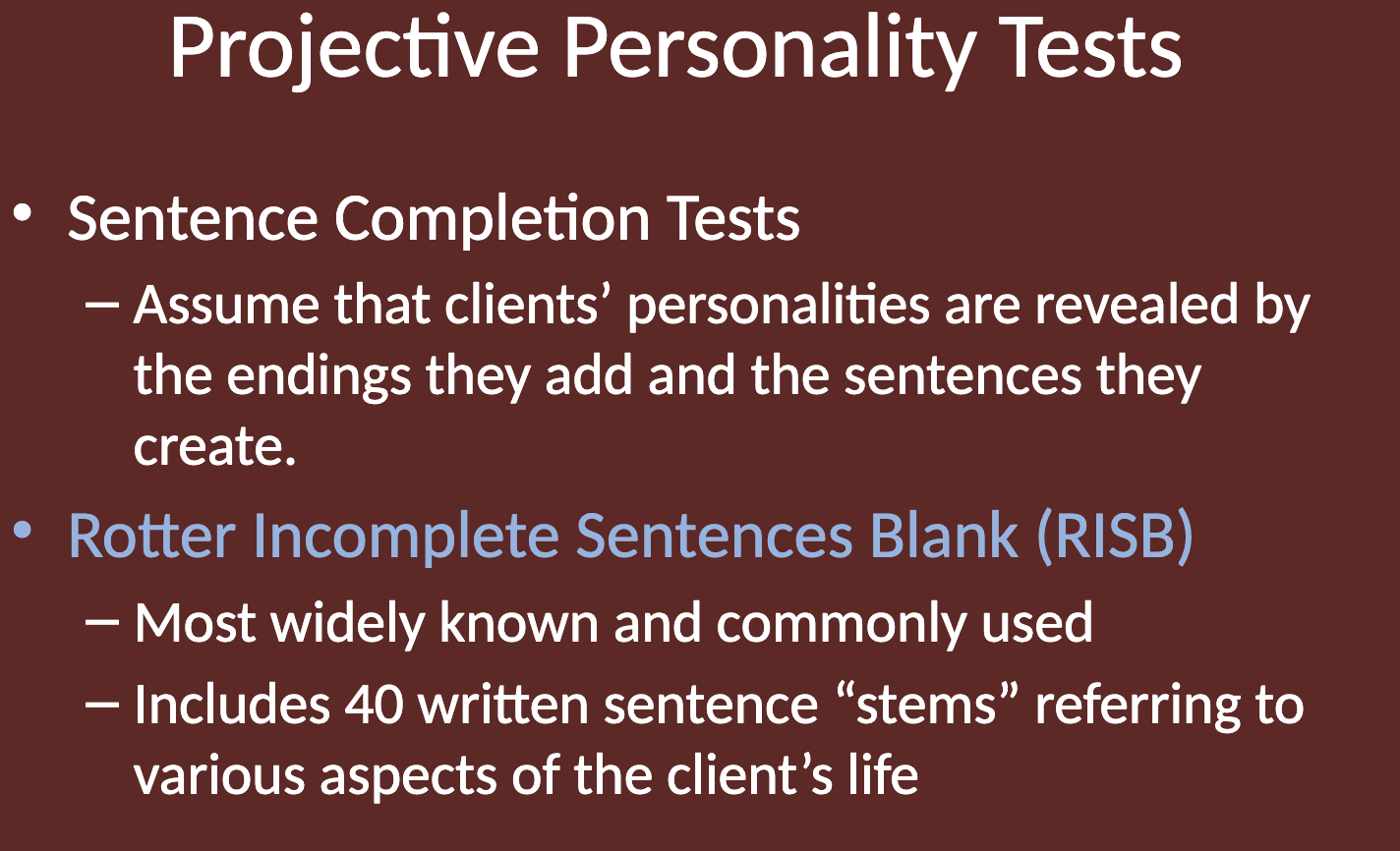
What is the Rotter Incomplete Sentences Blank (RISB)? (projective: RISB)
The Rotter Incomplete Sentences Blank (RISB) is the most widely known and commonly used sentence completion test. It consists of 40 written sentence "stems" that refer to various aspects of the client’s life, aimed at exploring their thoughts, feelings, and attitudes.
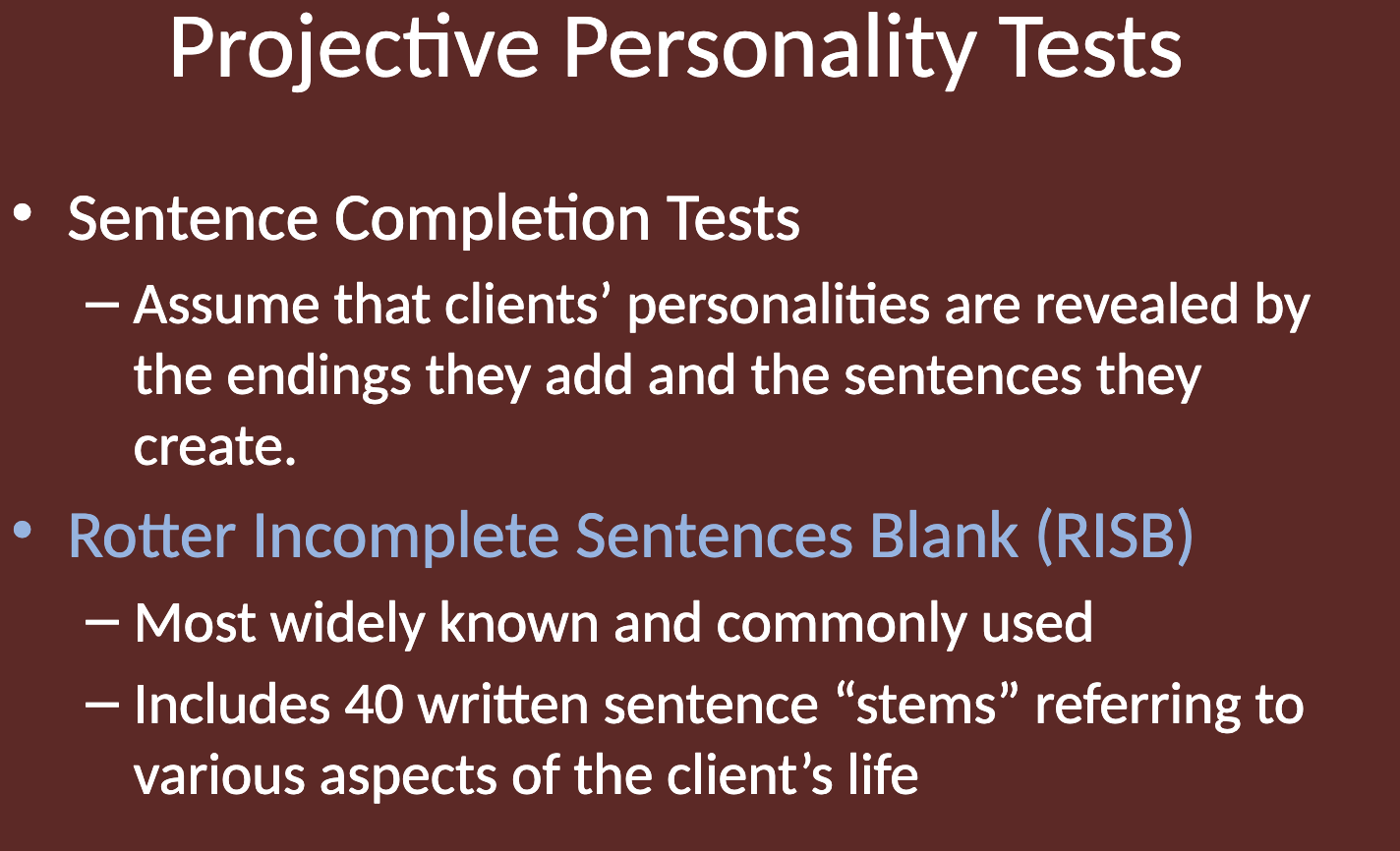
What are some examples of simulated sentence stems from the Rotter Incomplete Sentences Blank (RISB)? (projective: RISB)
Examples of RISB sentence stems include:
I enjoy __________.
It makes me furious __________.
I feel very nervous __________.
My proudest moment __________.
My greatest weakness __________.
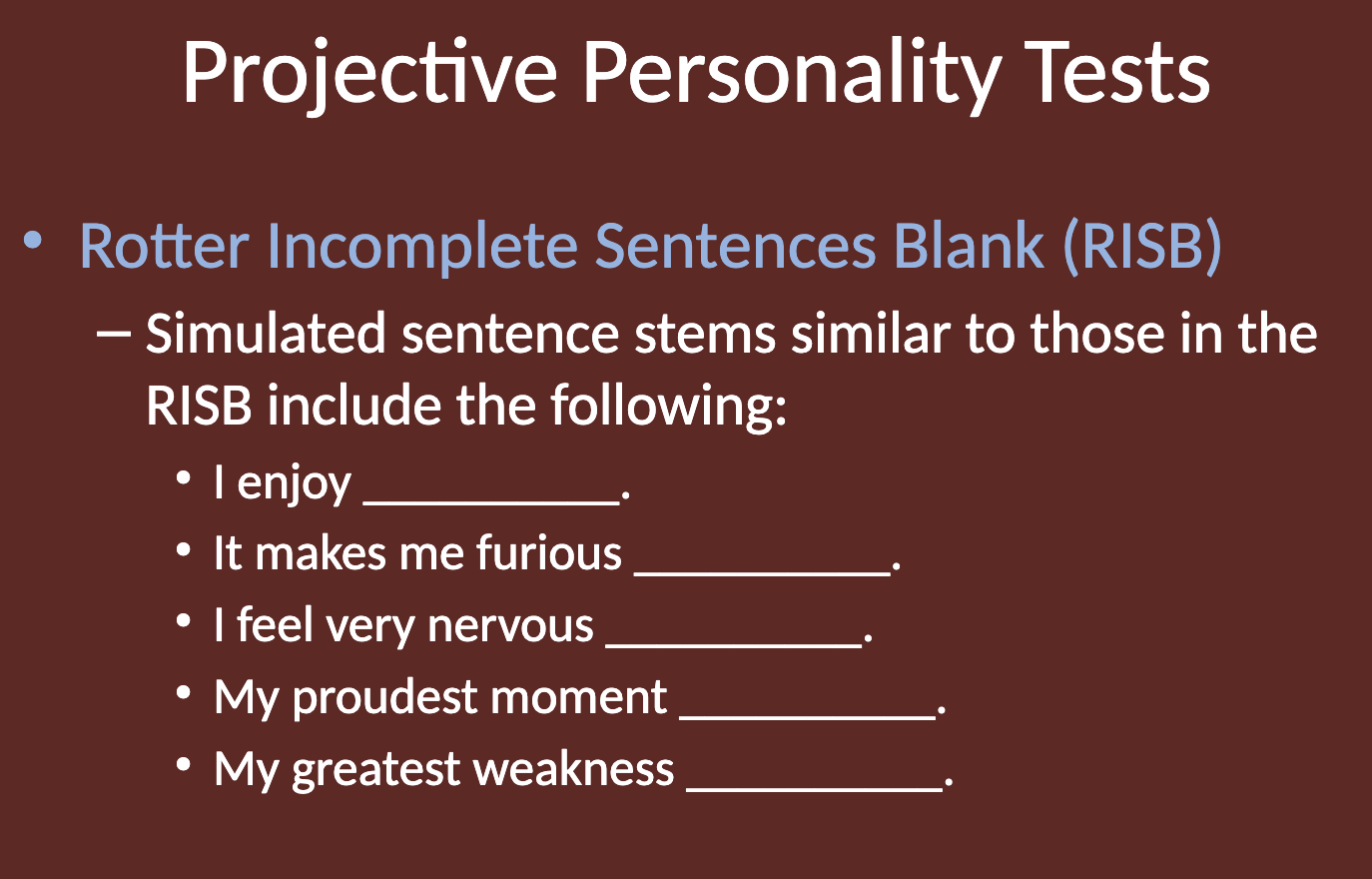
What is the scoring system for the Rotter Incomplete Sentences Blank (RISB)? (projective: RISB)
The RISB includes a formal scoring system, but clinical psychologists may not use it regularly. When they do, scoring is often dependent on the clinical judgment of the psychologist. This subjective approach raises questions about the scientific standing of the test.
The RISB is often used to supplement information obtained through other tests, including objective personality tests.
